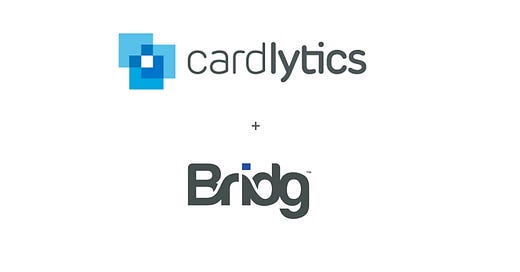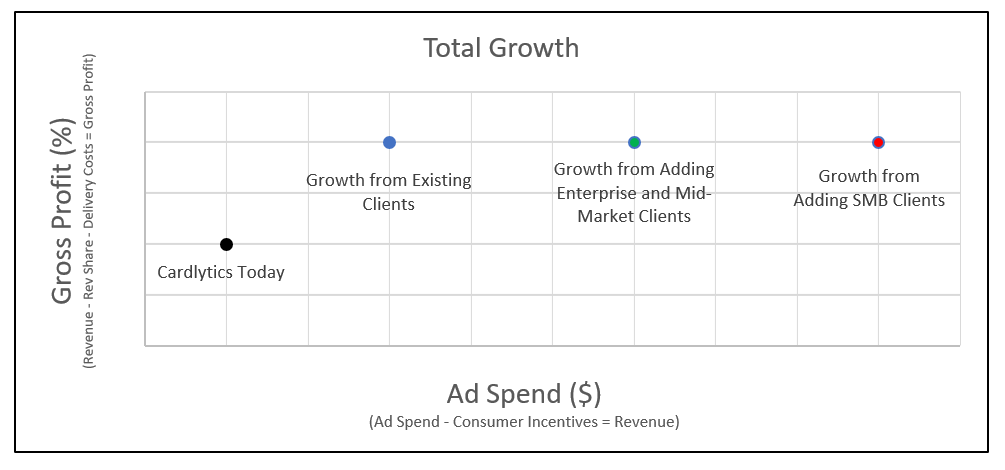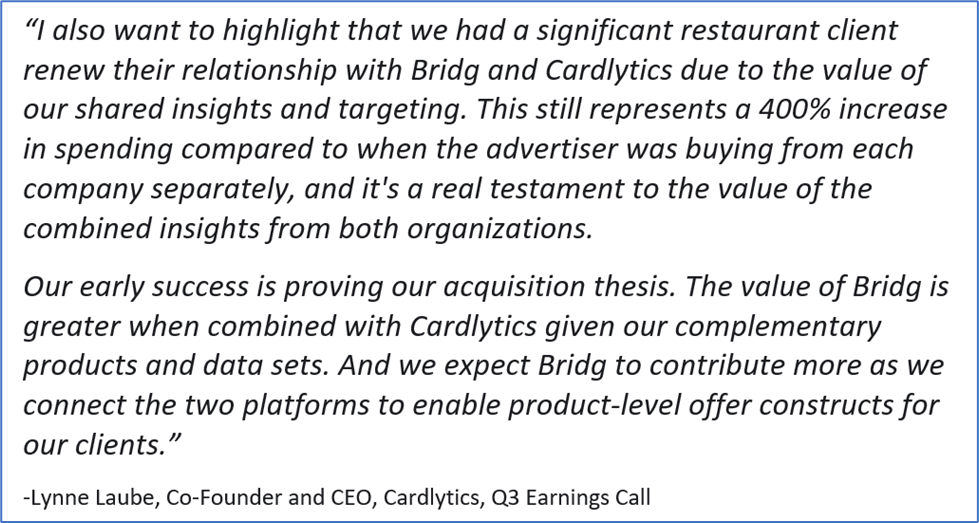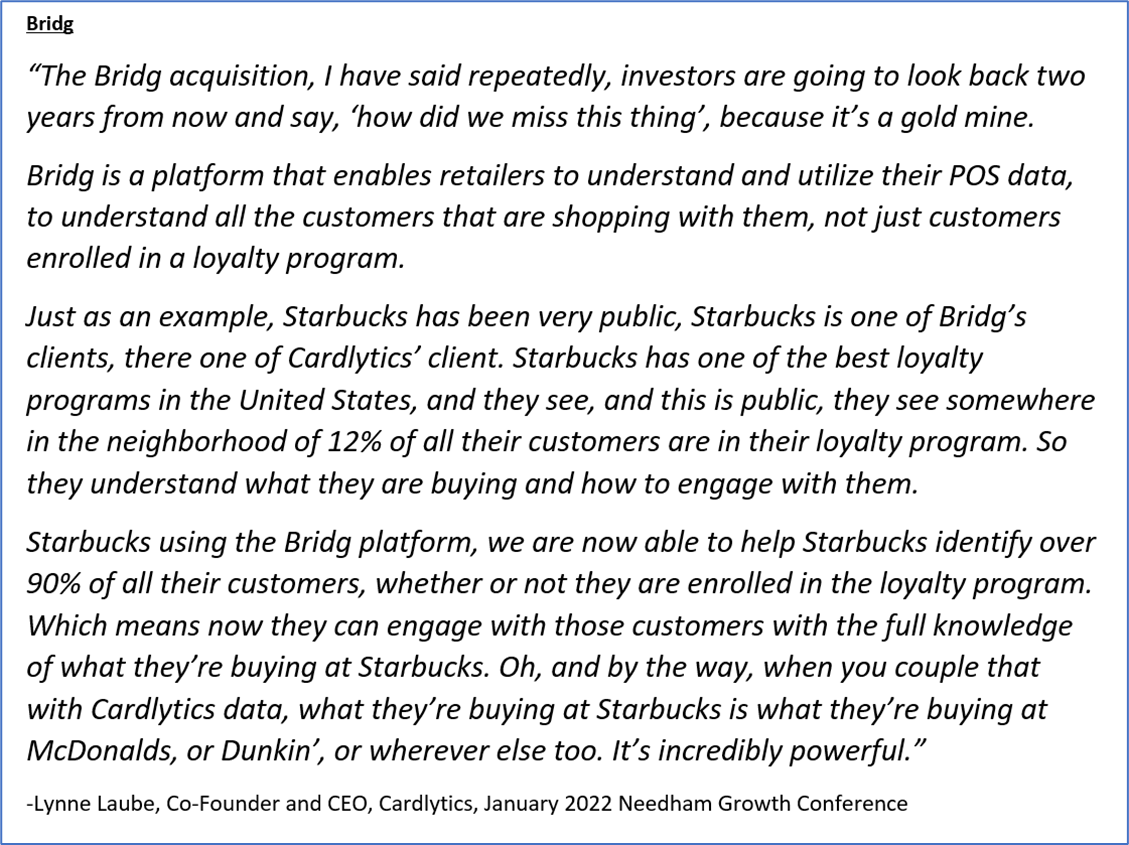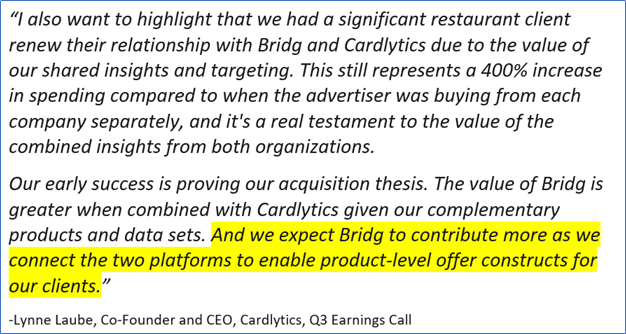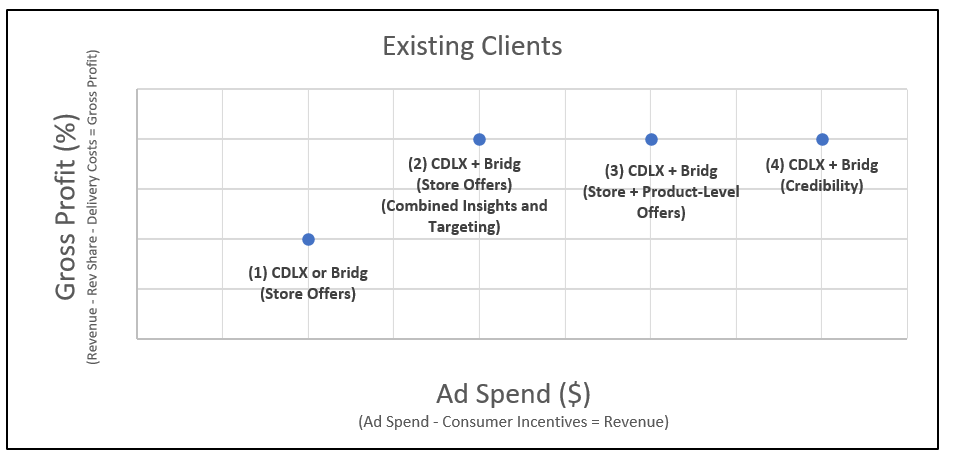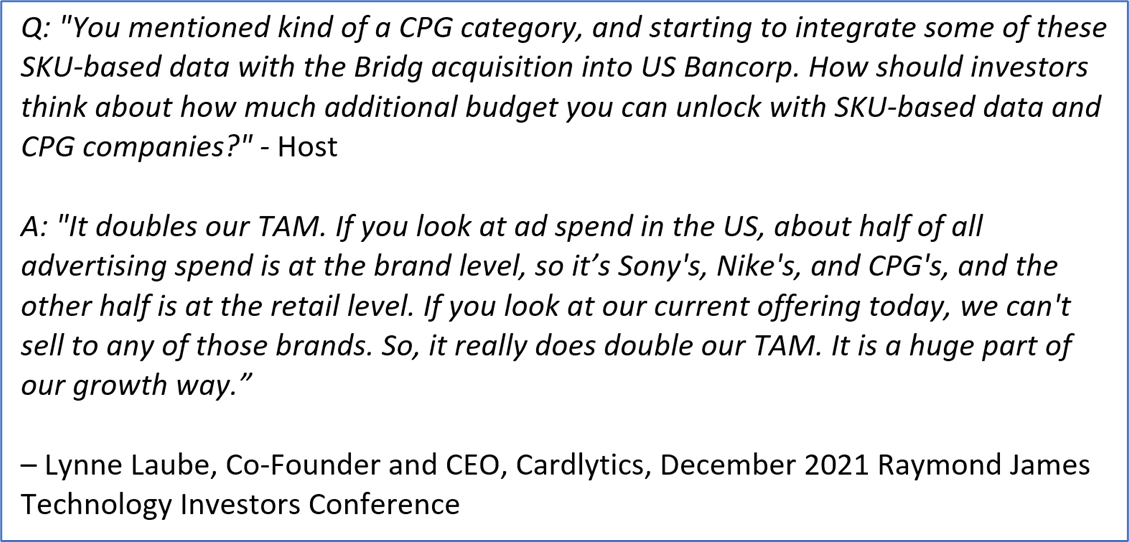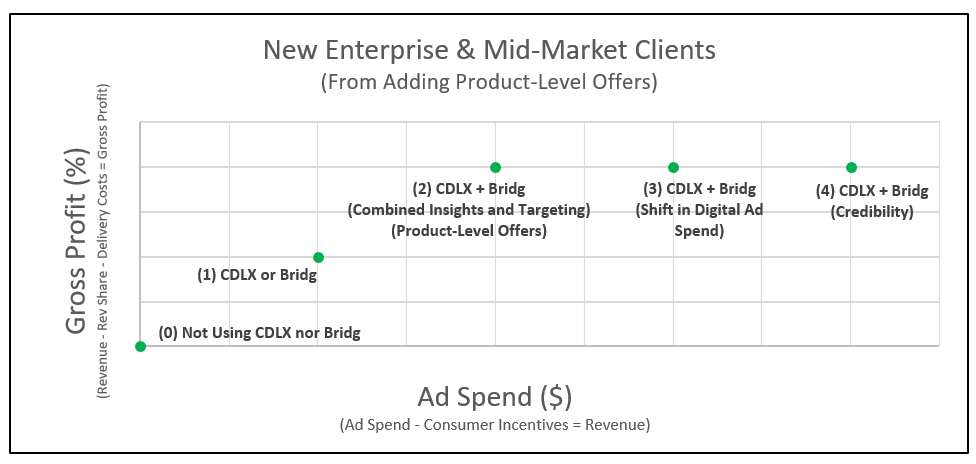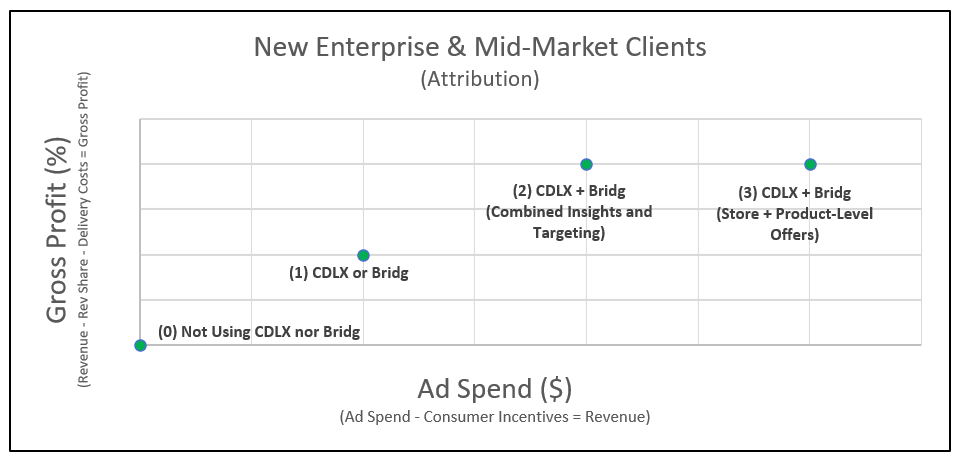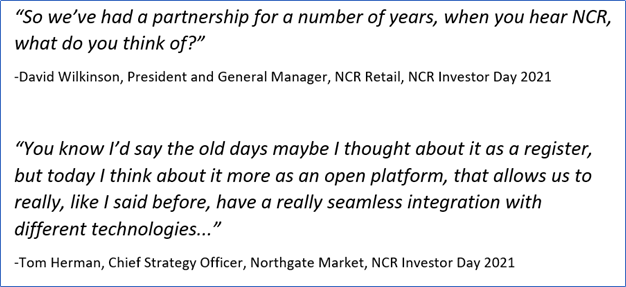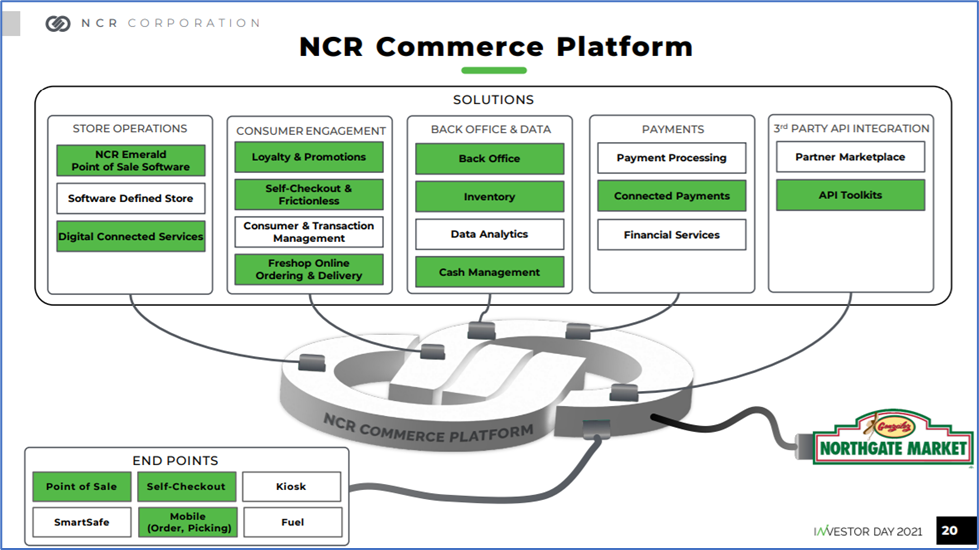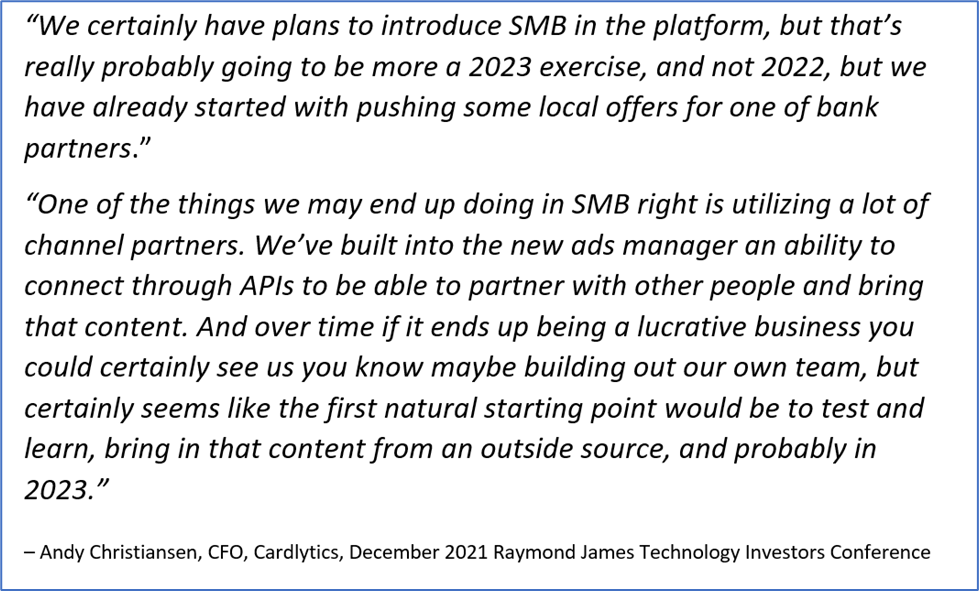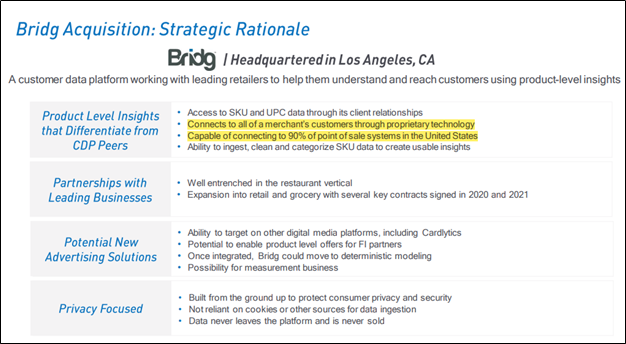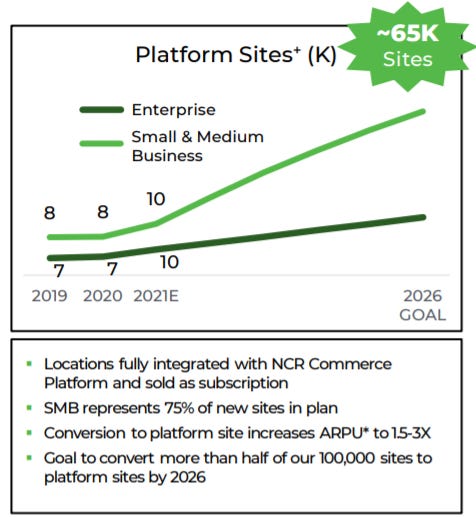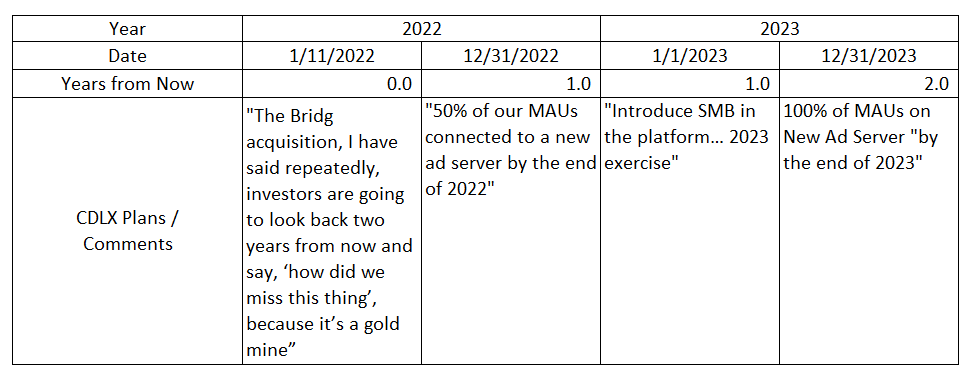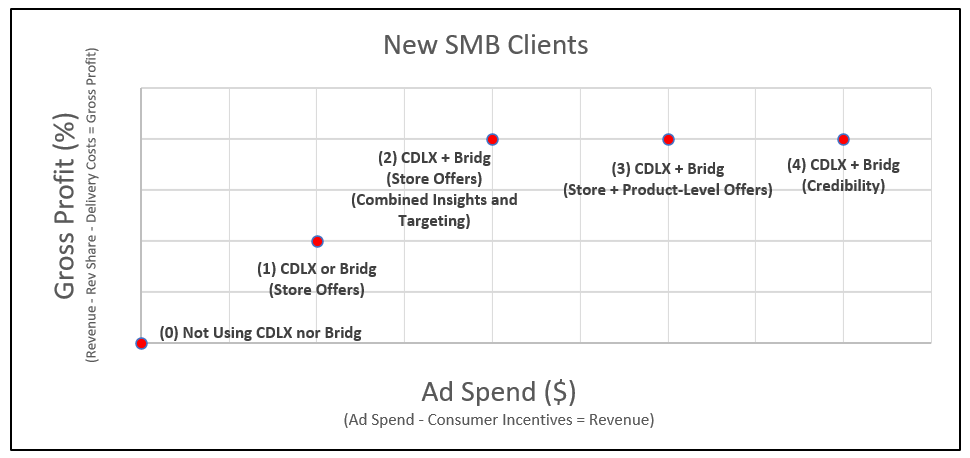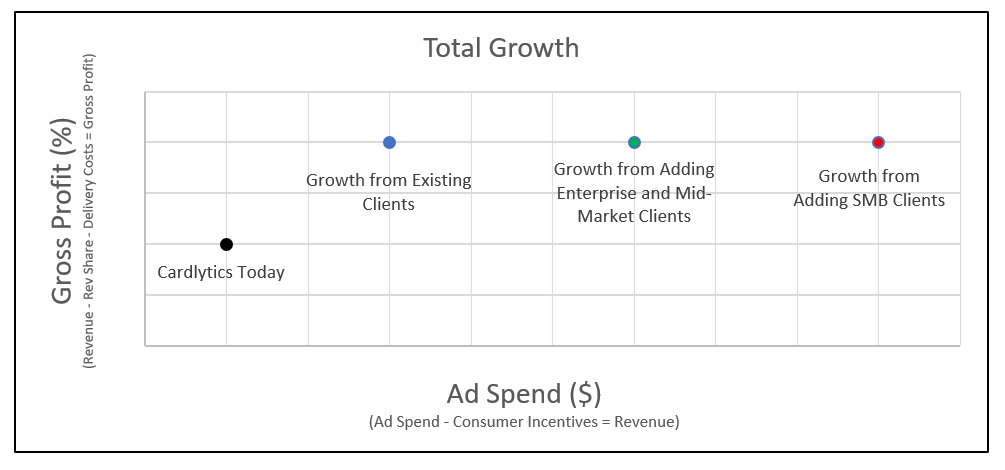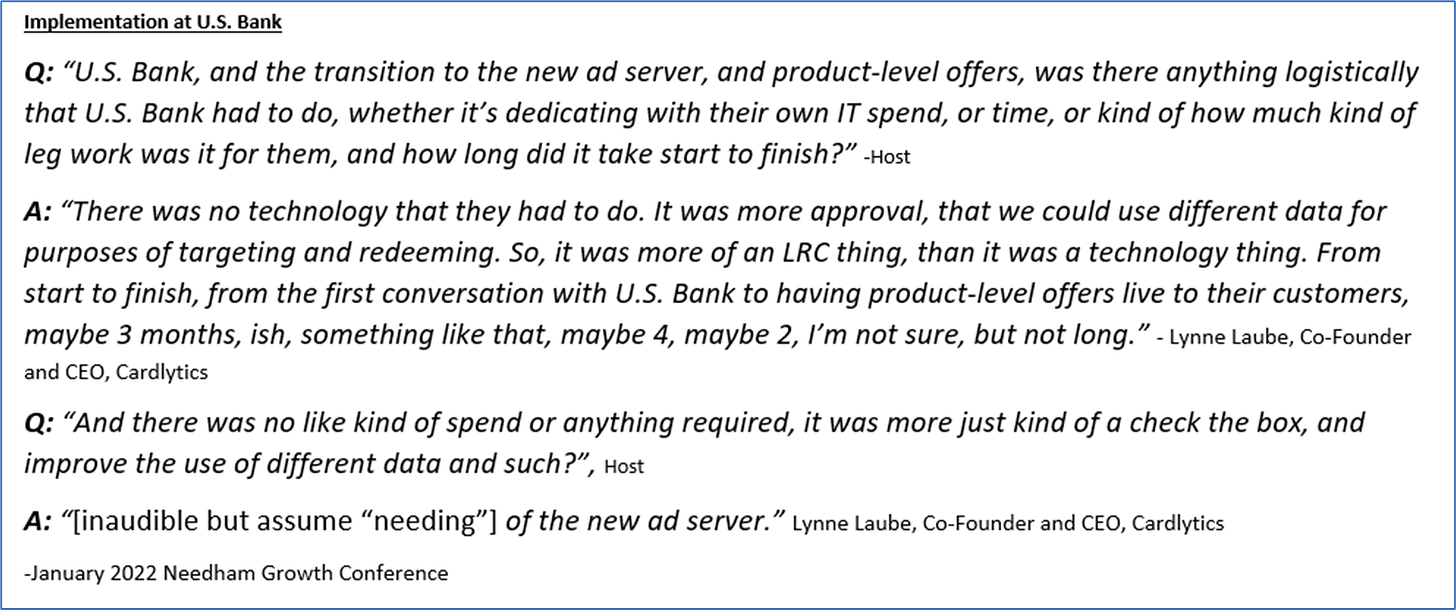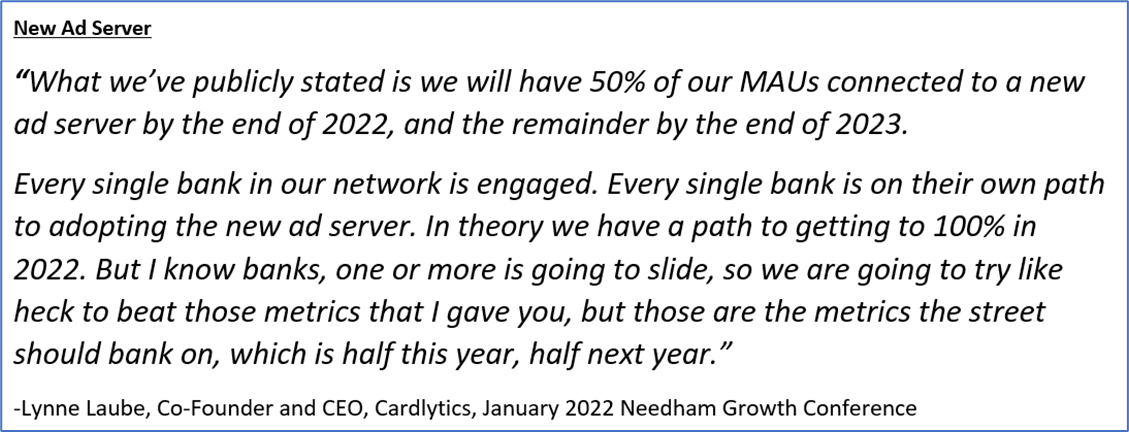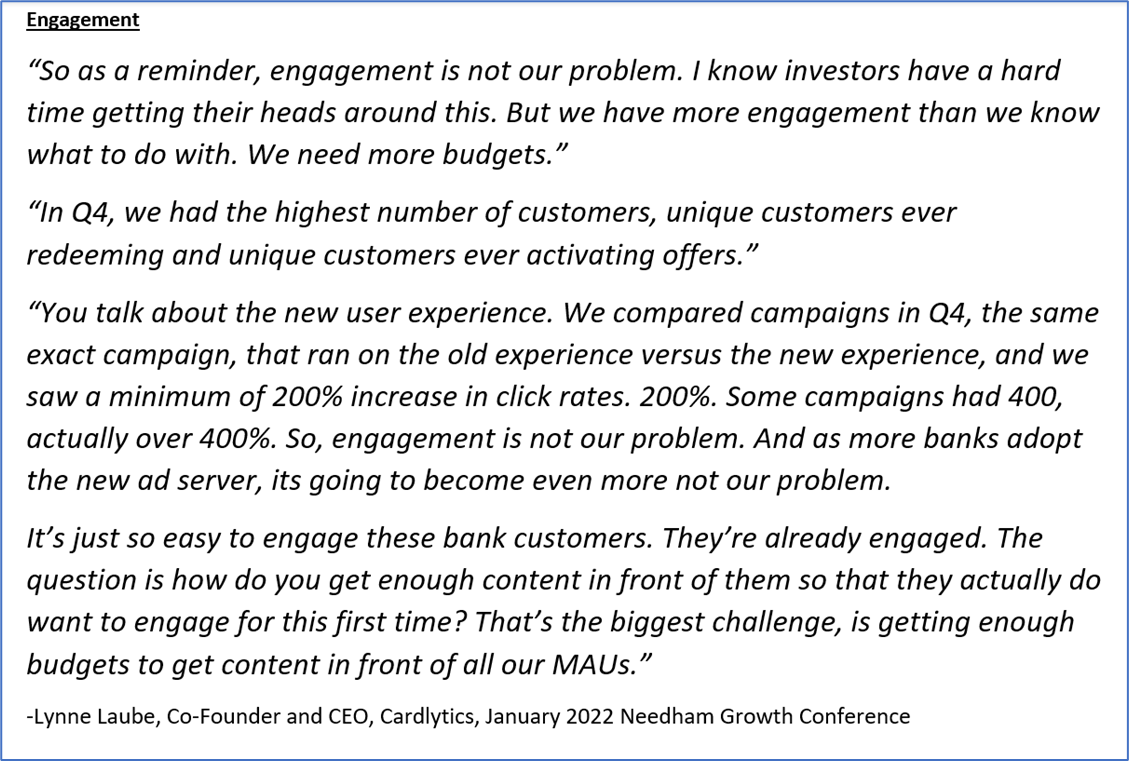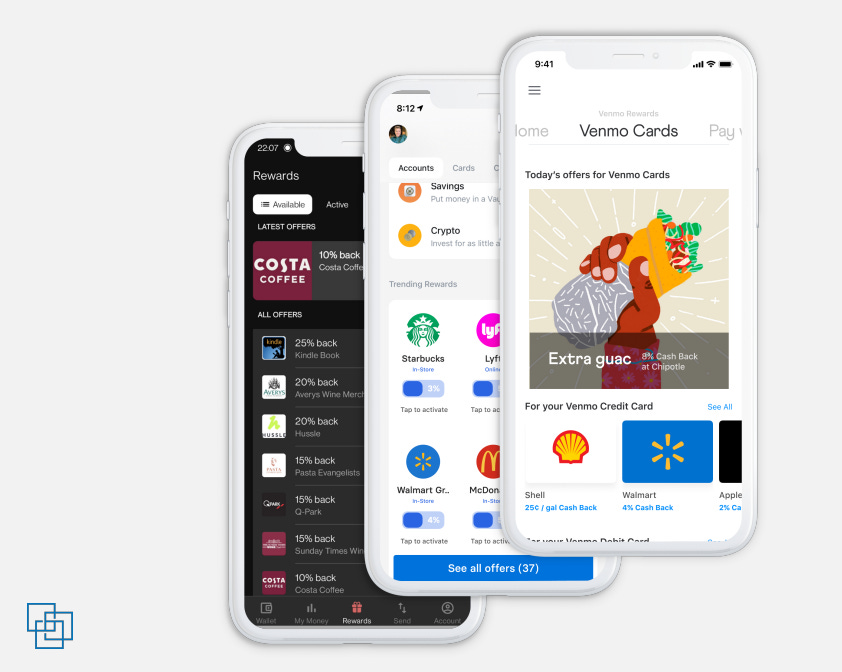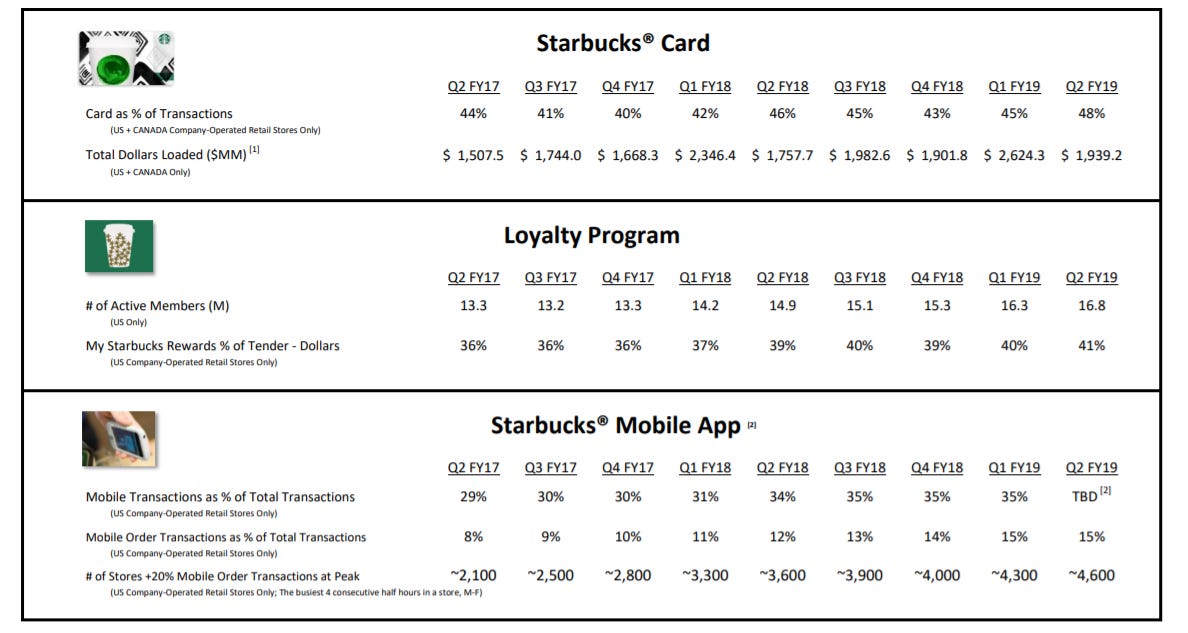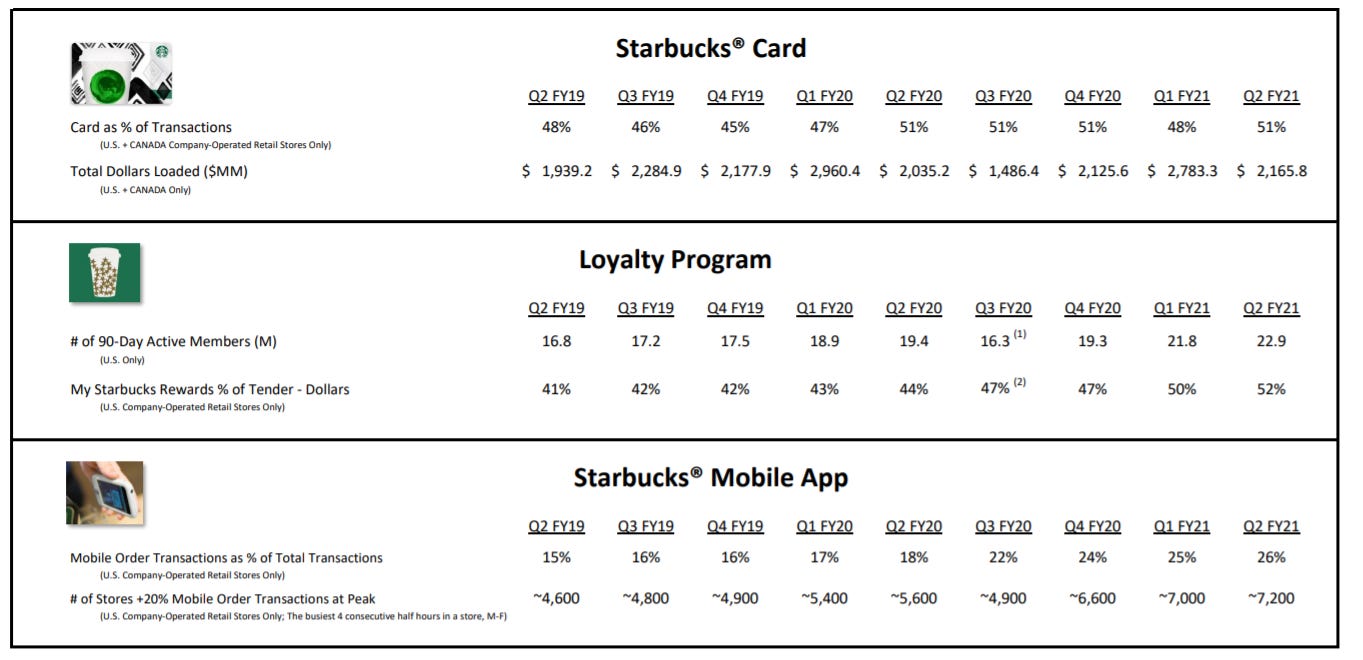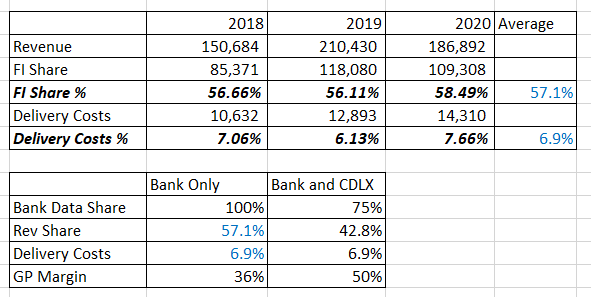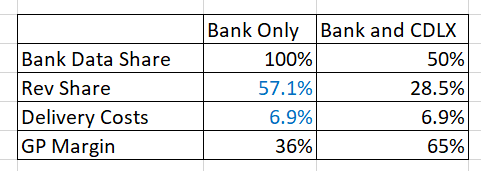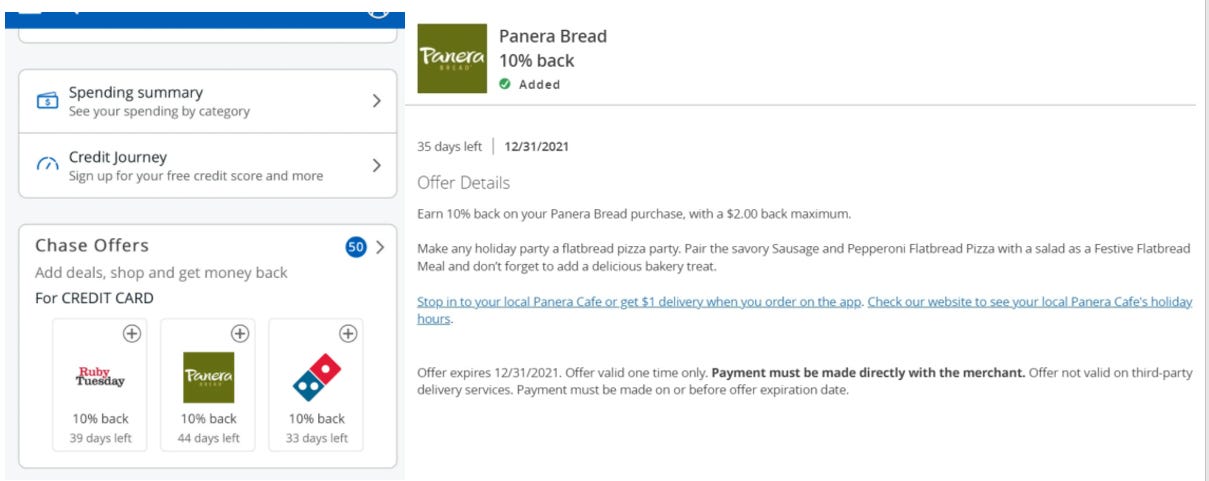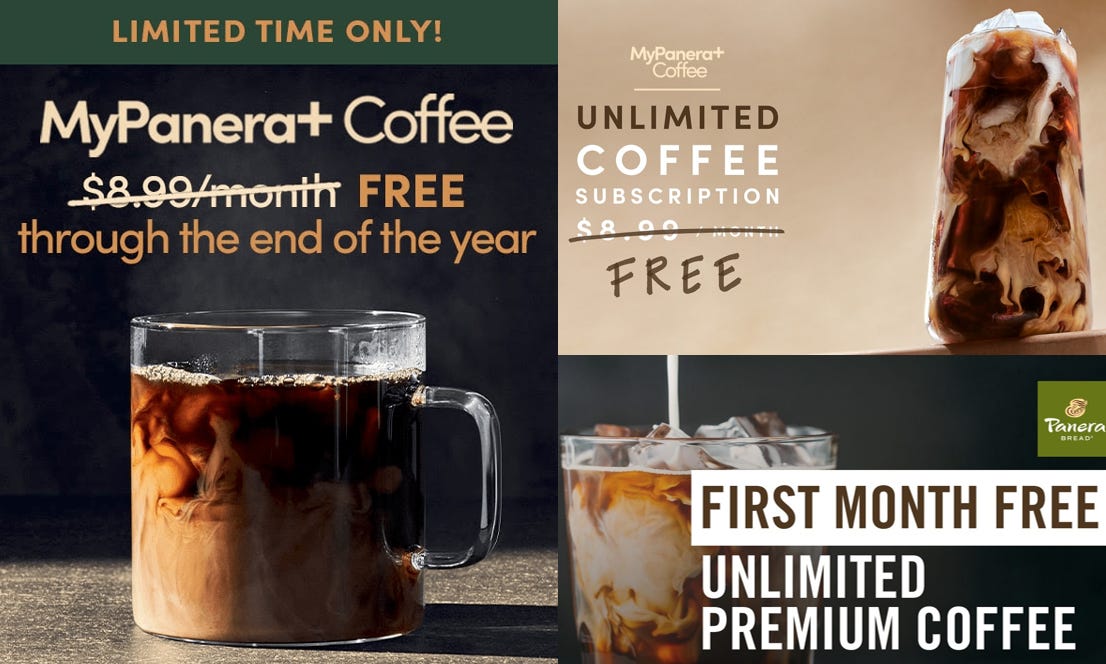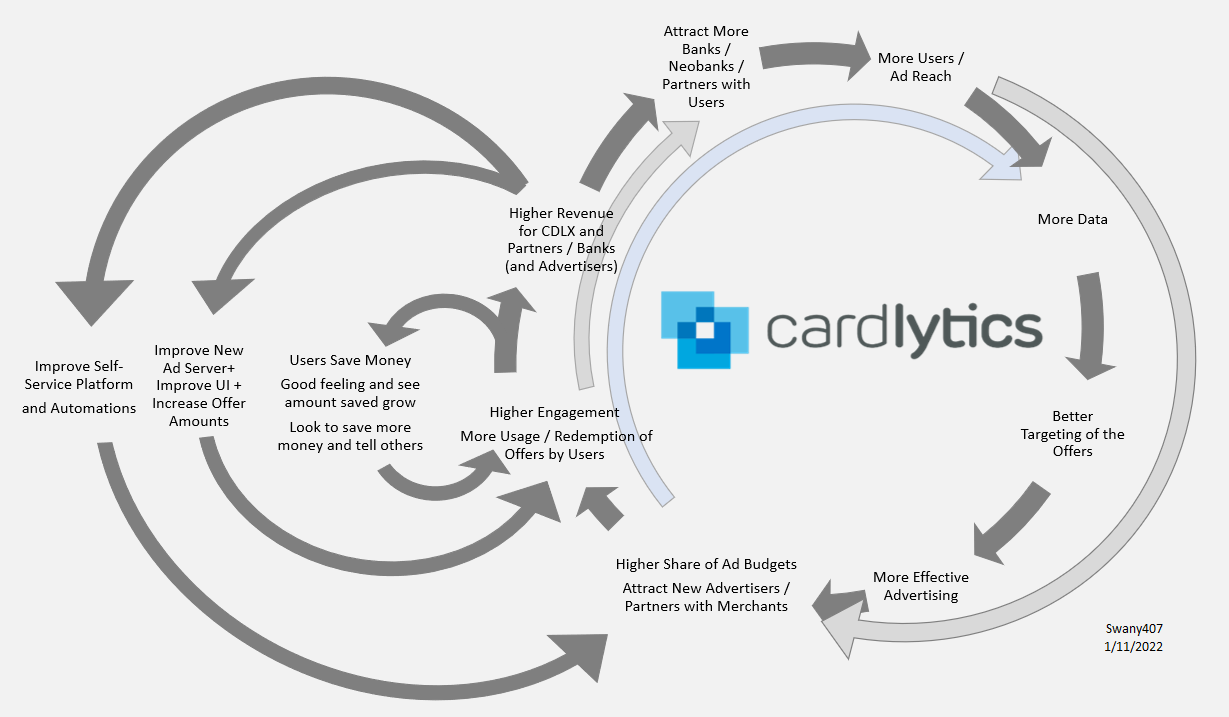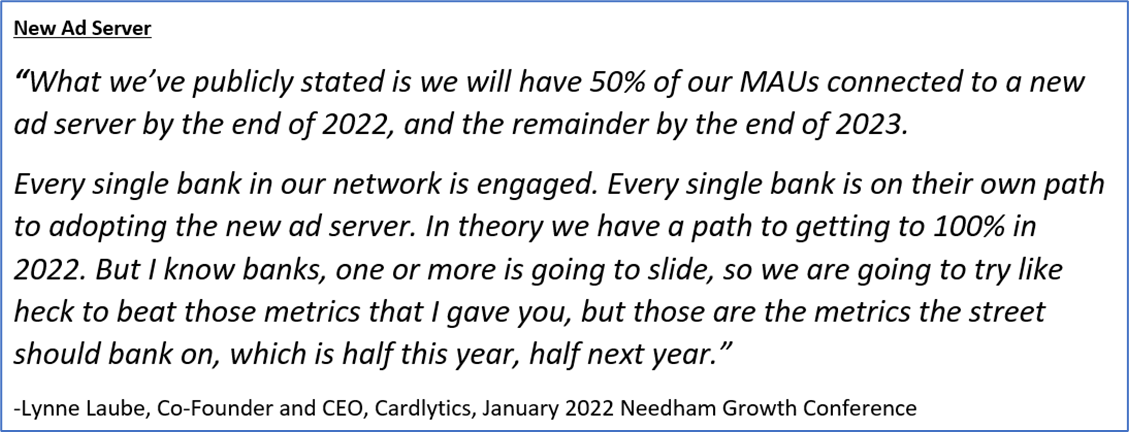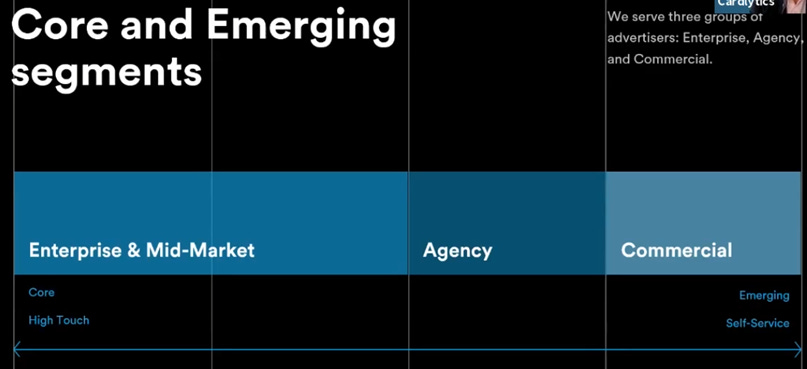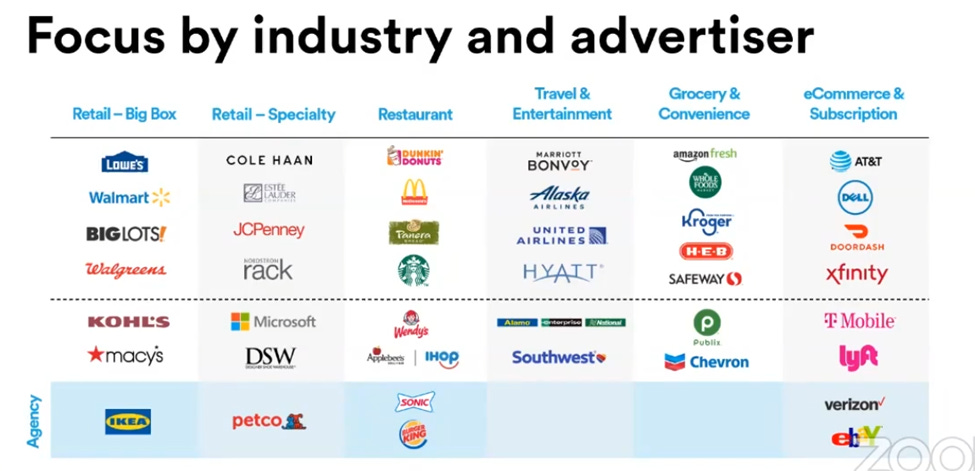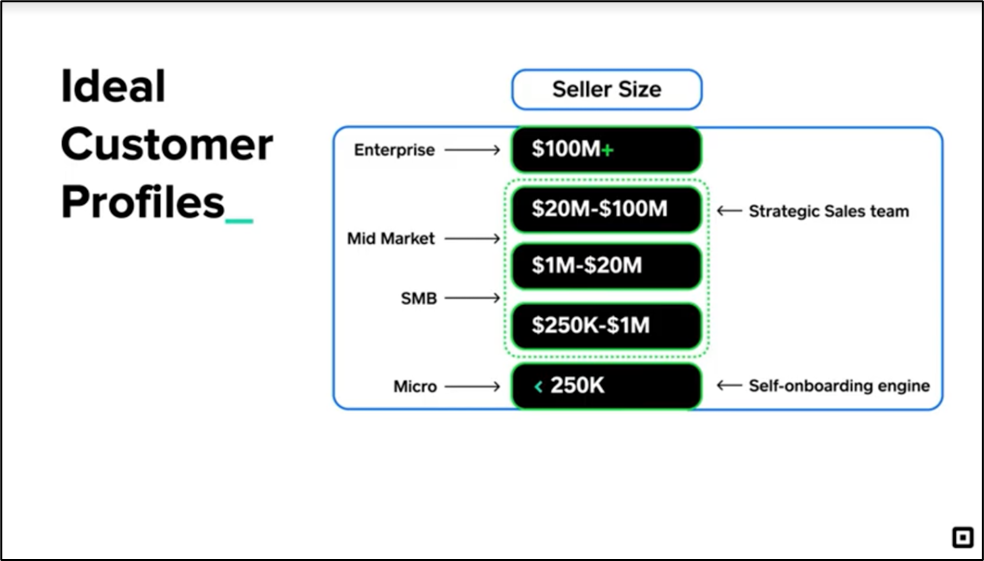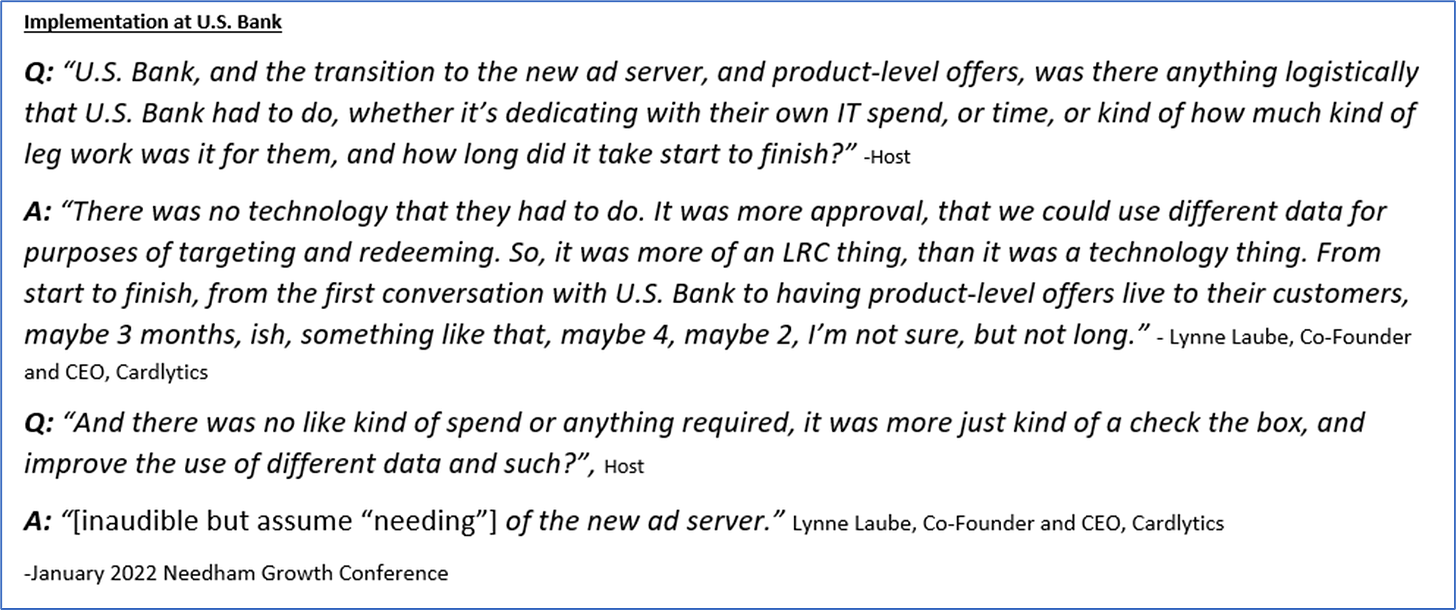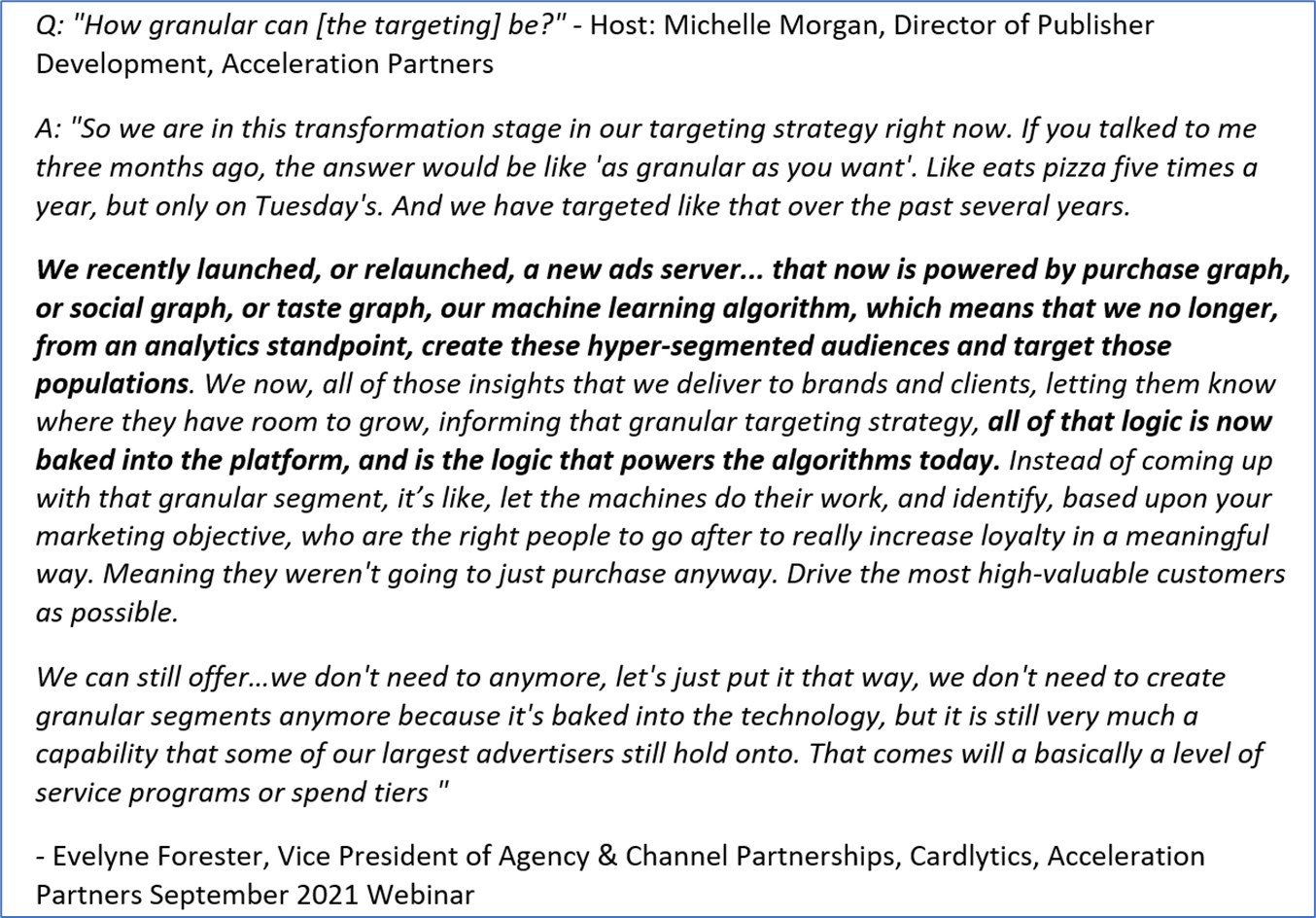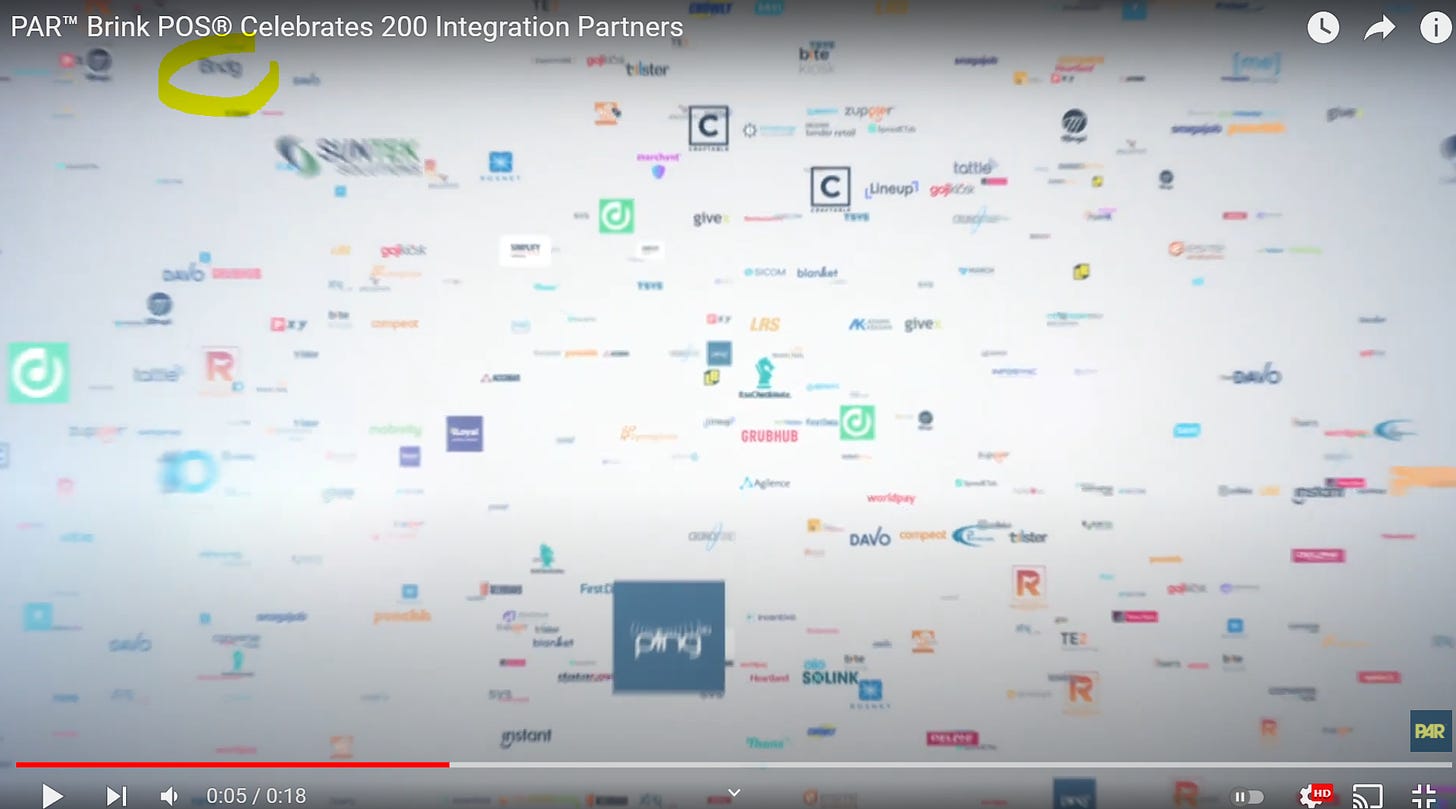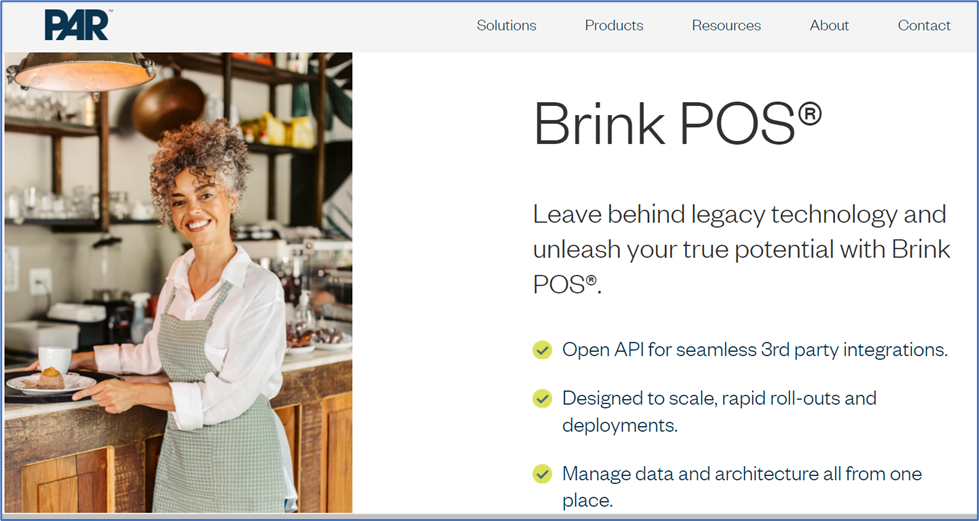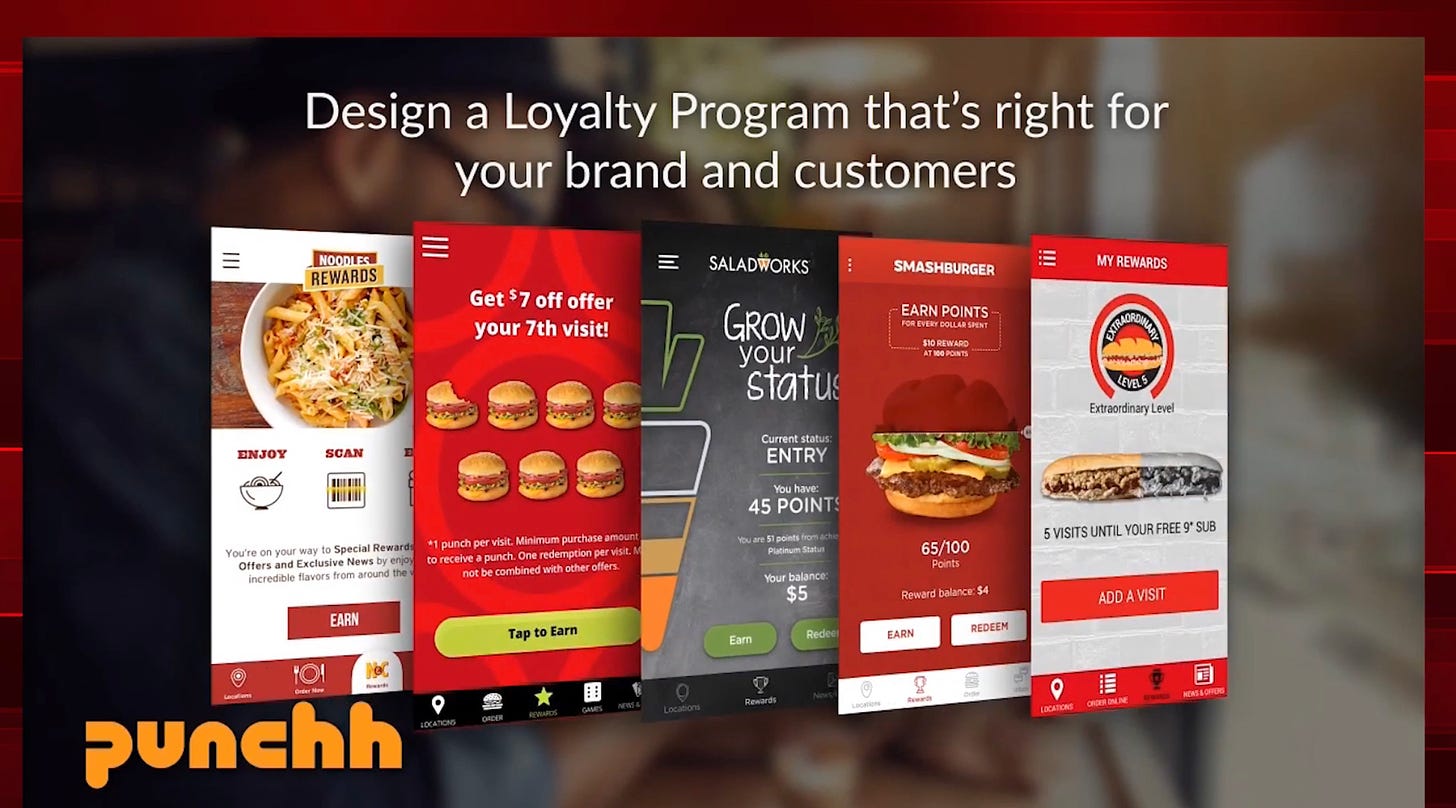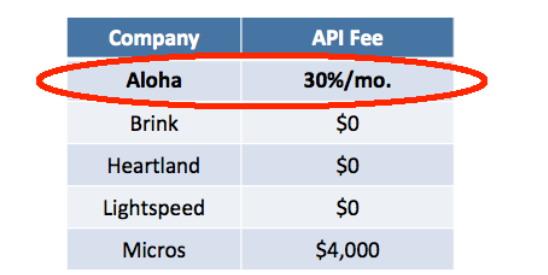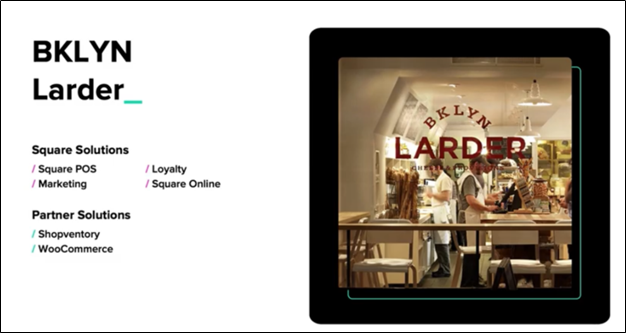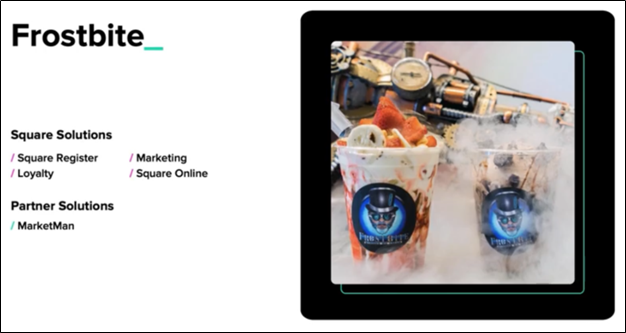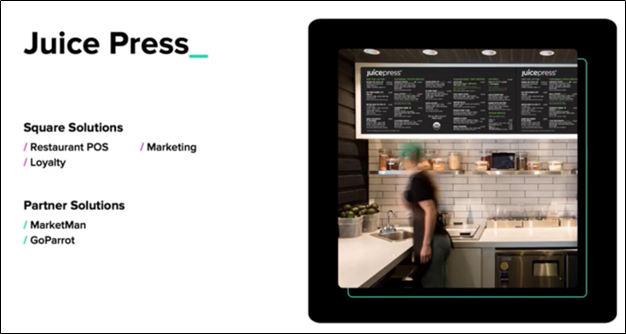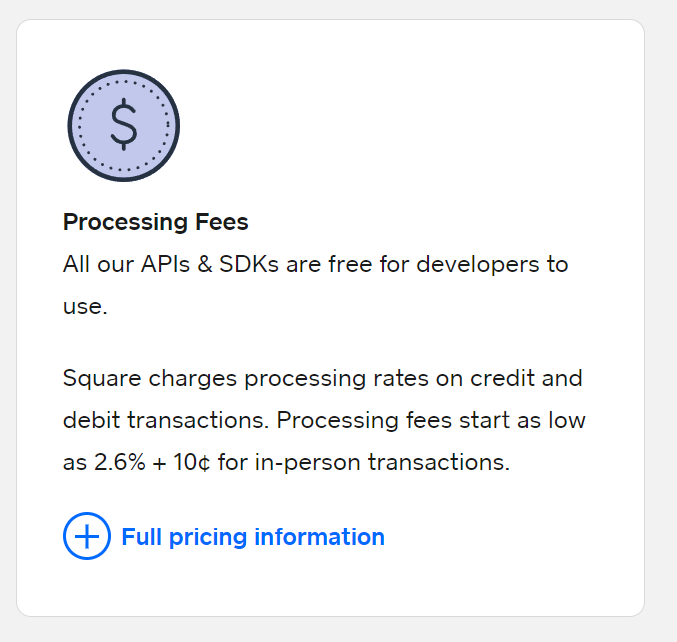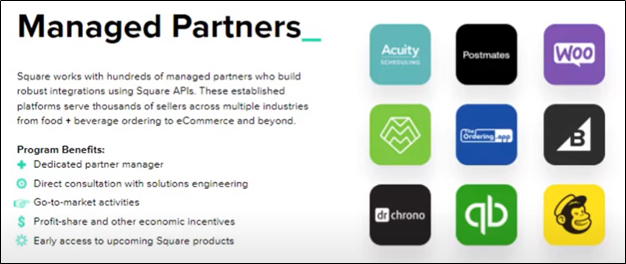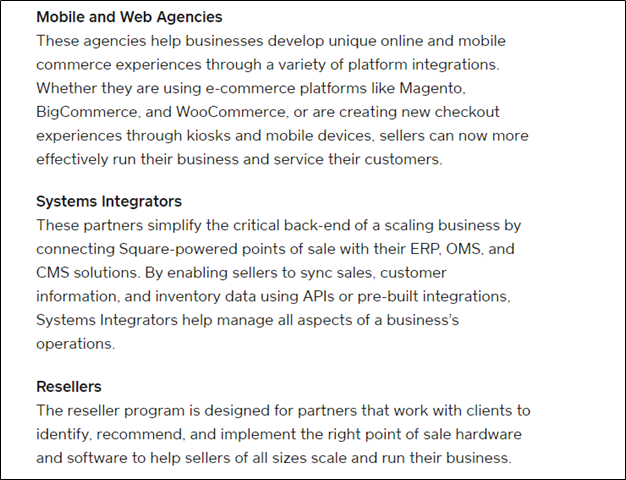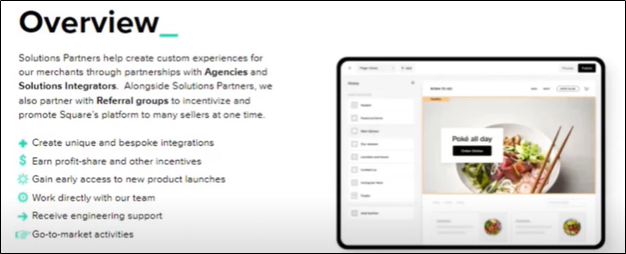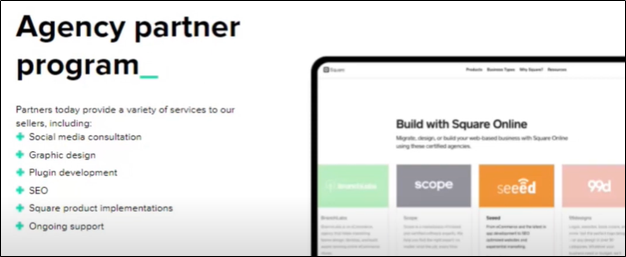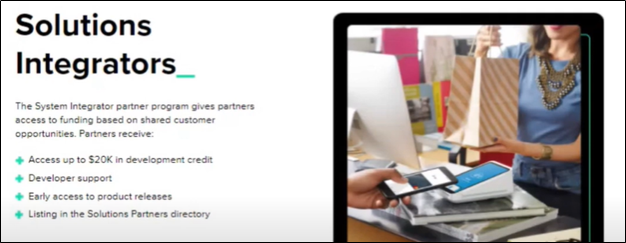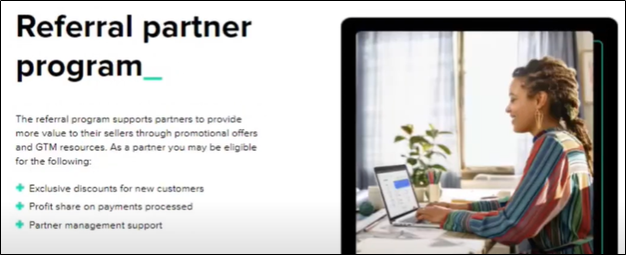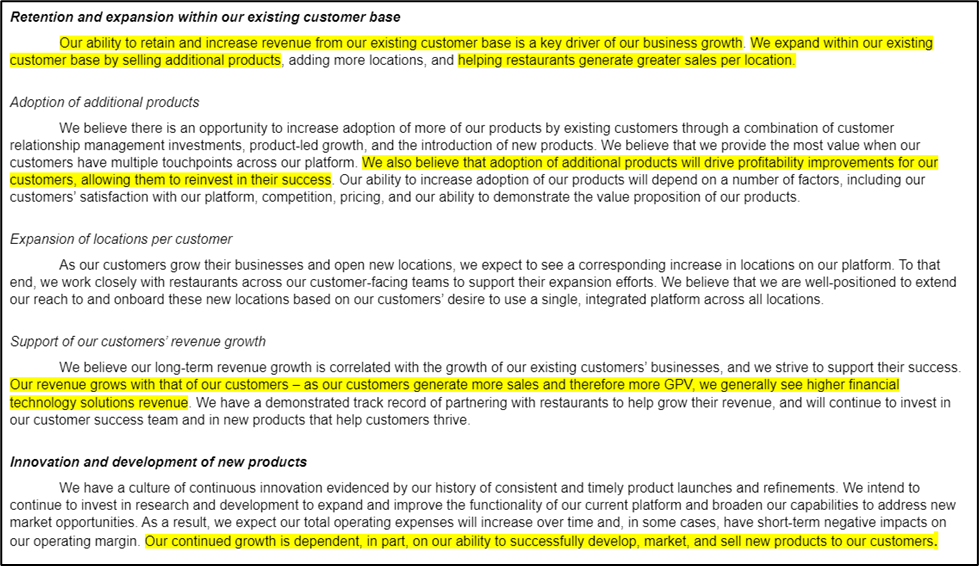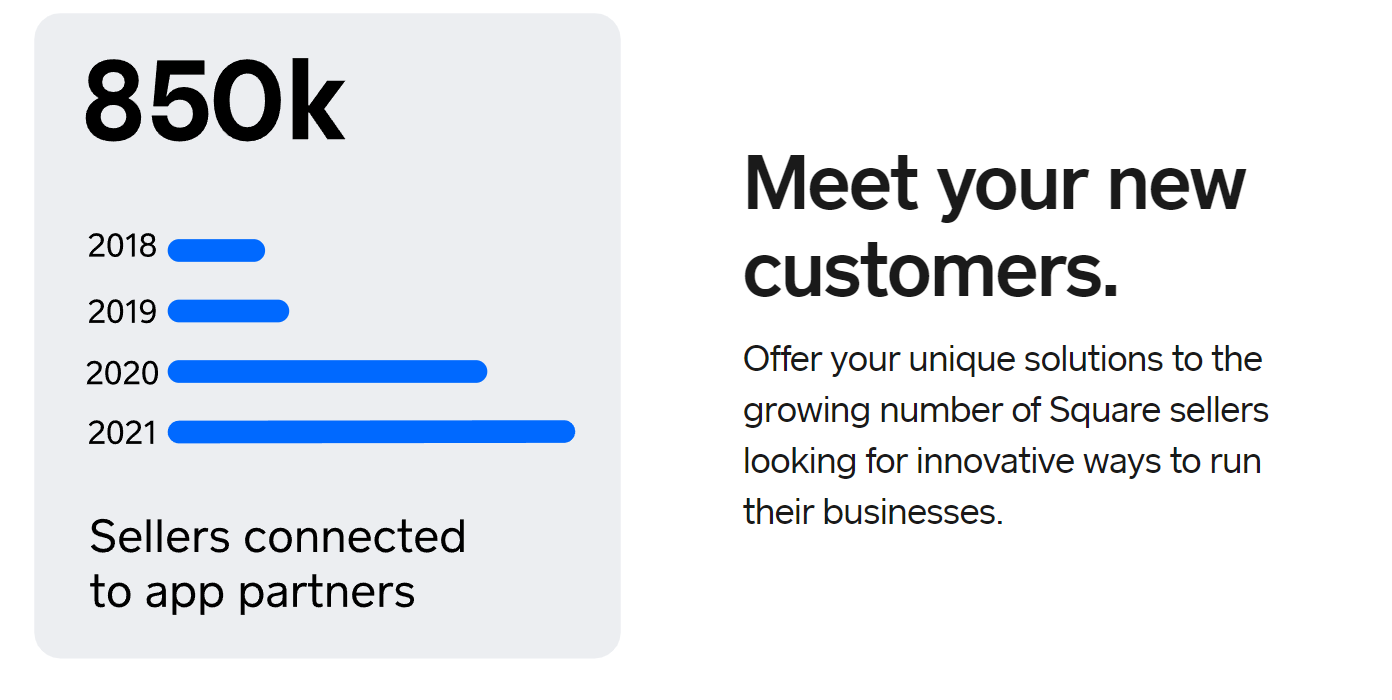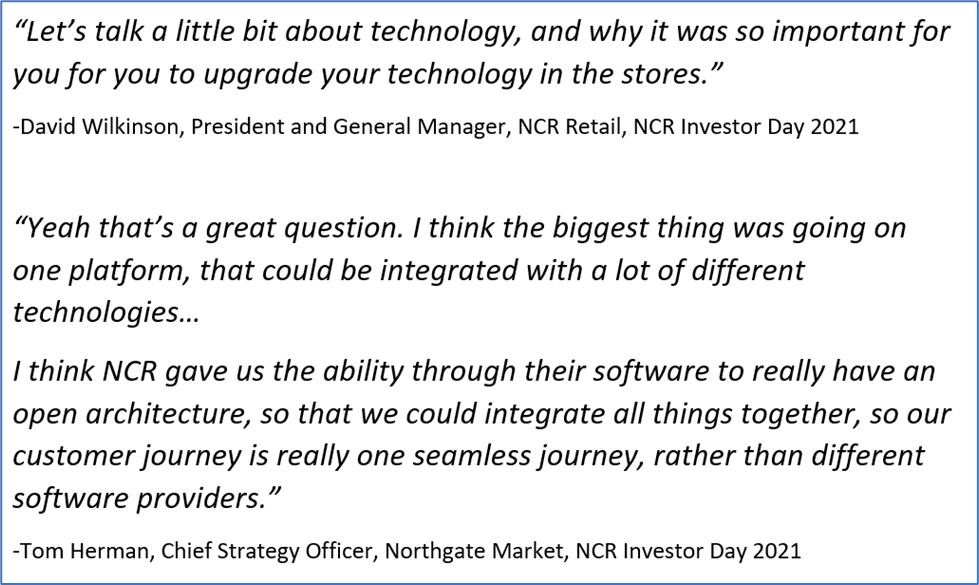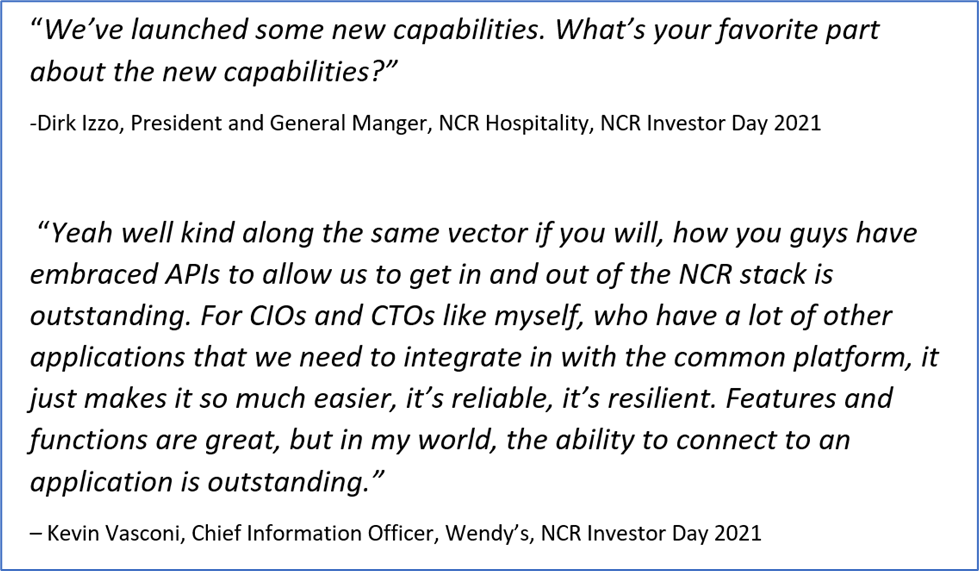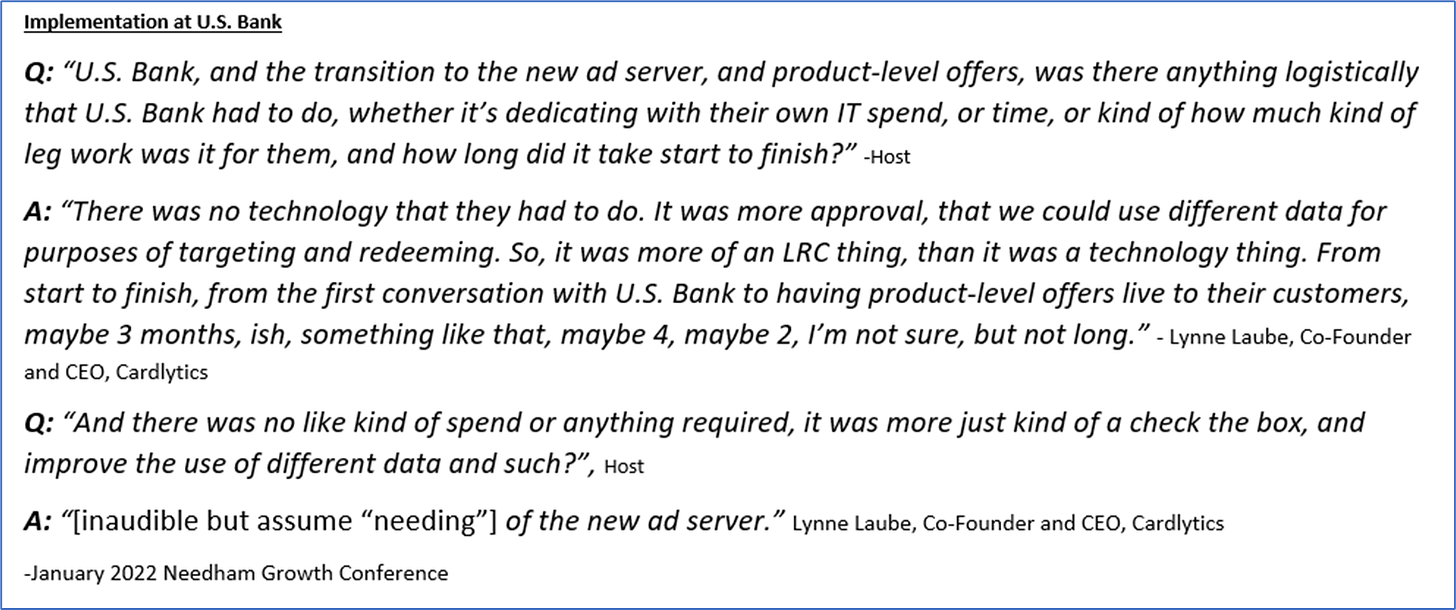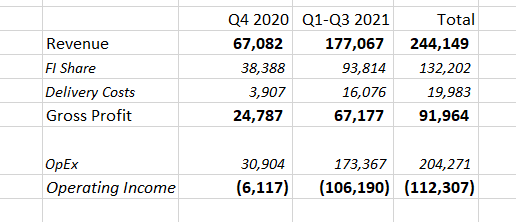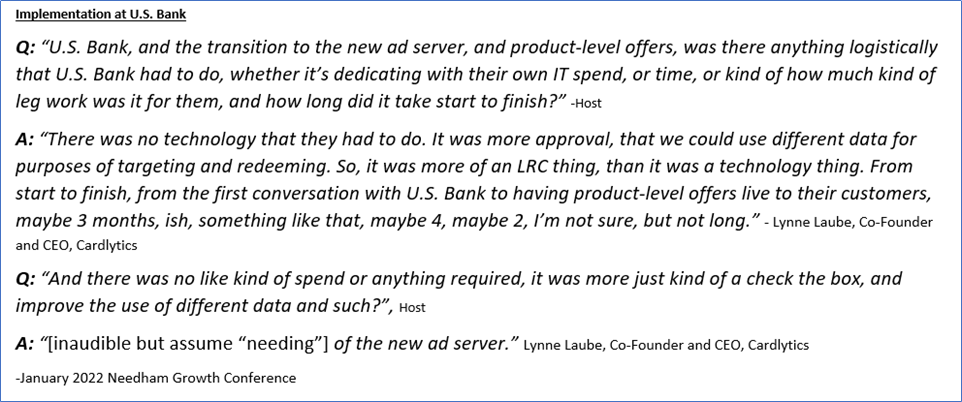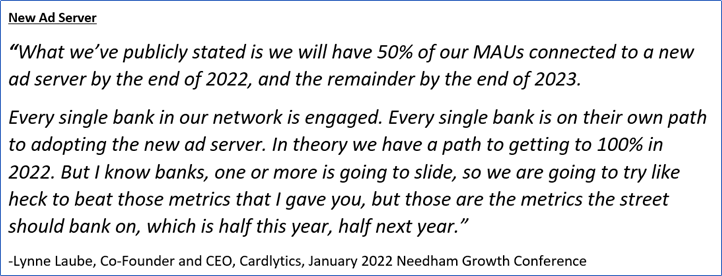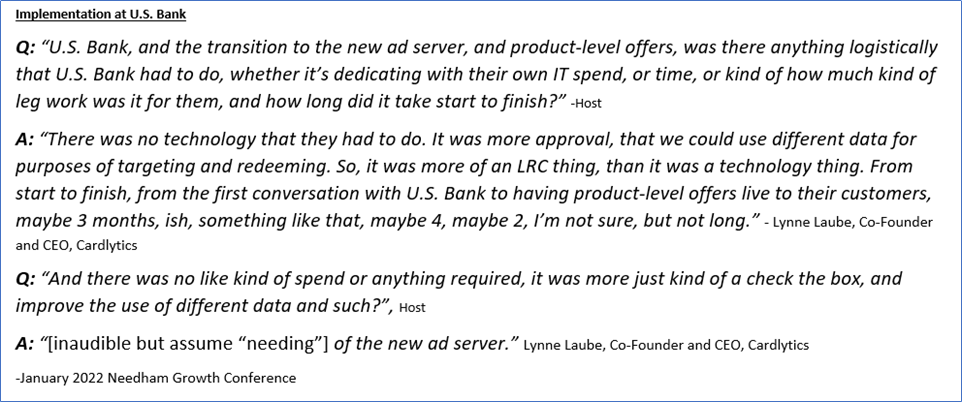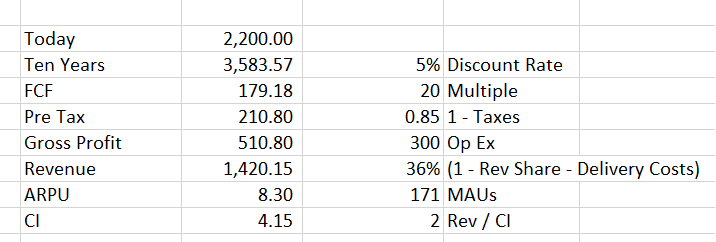Cardlytics ($CDLX): The Power of Bridg (and Why CDLX is Undervalued)
Bridg could lead to high levels of growth from combined insights and targeting, product-level offers, solving the attribution problem, and partnering with POS systems (like Toast, Square, PAR, NCR).
For all my notes on CDLX, check out my Qualitative and Quantitative “Research Notes”:
Pictures may be more clear when viewed on a desktop.
For those interested, this post is also available on YouTube, Apple Podcasts, and Spotify.
Market Cap as of 1.16.2022: $65.37/Share x 33.1M Shares ~ $2.2B Market Cap.
Please Note: The majority of this post is in the footnotes. While some of the footnotes are for sources, most are related to extra details for those interested. I tried to specifically call this out when it occurs, rather than just a number which refers to sources.
This was done to keep the main body of this post as short as possible, while still including all my relevant notes for those interested. My hope is those who want a shorter read, can read the main body of this post and still get the most important information. For the video and podcast, I will be going through the main body first, then the footnotes.
If you have questions, my hope is most answers are in the footnotes, but feel free to reach out to me directly.
Introduction
Cardlytics acquired Bridg, a customer data platform with SKU-level (or product-level) insights from POS systems, in April 2021, for $350M (with two potential earnout payments that could total between $100M to $300M)1. Bridg will enable SKU-level insights and targeting, as well as product-level offers, previously not possible with Cardlytics.
Over the next two years Cardlytics will likely experience significant increases in ad spend and revenue, and at higher-than-normal gross profit margins due to lower revenue share, all from utilizing Bridg.
I believe there will be three stages of growth with Cardlytics + Bridg:
Growth from Existing Clients
Growth from Adding Enterprise & Mid-Market Clients
Growth from Adding SMB Clients
Each stage will contribute to Cardlytics increasing levels of ad spend / “billings” (and consequently revenue) and at higher gross profit margins, all directly related to Bridg (for financial definitions, see the footnotes2).
The higher-than-expected growth will be generally due to:
Growth from combined insights and targeting from Cardlytics + Bridg
Growth from product-level offers
Growth from solving the attribution problem
Growth from partnering with POS systems (like Toast, Square, PAR, and NCR)
I believe many of these items from Bridg will address previous desires and issues expressed by advertisers, which when solved with Bridg, it will contribute to Cardlytics’ growth in ad spend and revenue.
This growth from Bridg will require the new ad server to use the data and place and redeem product-level offers. The current stated goal is to get 100% of MAUs on the new ad server by end of 2023, or 2 years from now, matching Lynne’s comment above regarding “investors are going to look back two years from now and say, ‘how did we miss this thing’ because it’s a gold mine.” (Information on the new ad server, timing, and engagement stats is in the footnotes3).
This potential growth is going unnoticed (or at least under discussed) and ignored (implied by the current market cap under reasonable assumptions), possibly due to the uncertainty on what’s possible or could happen with this relatively new acquisition.
I believe this is related to Lynne Laube’s comment in December 2021 on what investors do not understand or appreciate:
While all of the above is essentially a simplified updated investment thesis for Cardlytics (especially when combined with all the other growth factors ignored that will be mentioned in the closing of the write-up), this post will go into detail regarding Bridg and how it could exactly unfold.
I try not to be too aggressive or optimistic with assumptions or expectations with regards to investing, both in terms of my own investments and what I write about. While some areas of this discussion may come across as overly optimistic, or too good to me true for it to be going unnoticed, I do not believe my claims are out of line. Not only do I provide “reality checks” on my own work (such as where there are quantitative examples), but also nearly all items discussed are based around direct comments made by management, developments and updates that have actually occurred, actual changes in ad spend by clients, existing partnerships, and actual contract language. Therefore, the items discussed are less speculative and have a higher probability of occurring than one may first assume.
If you enjoy the content, or have received any value from the investment insights, discoveries, and thoughts shared, past or present, please consider subscribing or becoming a supporter / premium supporter of the channel. Your support increases the odds of more investment write-ups and content in the future.
Disclosure and Disclaimer
The terminology I use in this post, as well as the explanations for how this could work are my interpretations and may not be fully accurate.
The focus should be on the big picture. My hope is this helps others think about what may be possible and could occur, given management’s comments, company developments, actual changes in ad spend, contract language, existing and developing technology, and existing partnerships.
As always, this is not investment advice. This is for educational purposes only.
Growth from Existing Clients
I’ve divided existing clients into three groups.
Those that are already clients of both Cardlytics and Bridg
Bridg-only clients
Cardlytics-only clients
Given the benefits and desire to have combined insights and targeting ability, and placing product-level offers, I believe a large portion of existing clients will eventually become clients of both Cardlytics and Bridg (especially if it can become a simple process, such as via self-service through the new ads manager). As the number of clients of both Cardlytics and Bridg increases, the financial benefit that Cardlytics will realize will also increase, from each of the points discussed below. More simply stated, if a Cardlytics does not become a Bridg client, they will not get any of the benefits discussed below, which would also limit Cardlytics potential revenue and gross profit.
Growth from Combined Insights and Targeting
Increases in revenue would come from the additional ad spend from clients having the combined insights and targeting when using both Cardlytics and Bridg.
As a real quantitative example, one “significant restaurant client” had a 400% increase in their spending compared to when buying separate. Although it is hard to know the size of the original ad spending, it was coming from a significant client, rather than a smaller client who may have not been spending as much before, where a 400% would not mean as much. (My guess of the client is discussed in the footnotes4).
Therefore, we could expect that those that are already clients of both will increase ad spend as they begin to use the insights and targeting from combining both Cardlytics and Bridg. This is directly related to Lynne’s comment regarding “I don’t think investors appreciate the power of Bridg and Cardlytics’ data combined”.
One company where we could see the increase in ad spend even more is Panera, who earlier this year had said they used both Bridg and Cardlytics, but wasn’t seeing the benefit yet. At the same time, they mentioned more doubling of their ad spend next year, but this seems independent of the combined benefits of Bridg and Cardlytics, given their other comment. Therefore, as they also learn and experience these benefits from the data combined, we could see someone like Panera, or anyone else who is already a client of both, start increasing their ad spend even more.
In order for Cardlytics to experience the highest increases in revenue, they will also need to get those that are only Cardlytics clients and only Bridg clients to become clients of both.
I believe those that are currently clients of Bridg will be able to easily add in Cardlytics data and insights and be able to place offers in the bank channel. Given Cardlytics’ new ad manager has a self-service component, and given Cardlytics’ new ad server has more automation such as using machine learning for targeting to be more hands off (discussed more in the SMB section later), I feel it should be easy for Bridg to simply use Cardlytics for both the data and to place offers. We know this integration is possible, given product-level offers are now live at U.S. Bank (or at least testing)5.
Those that are only Cardlytics clients, it may become as simple as within the self-service platform of Cardlytics having something that says, “Want to add SKU-level data and product-level offers? Simply log in to your POS platform to connect via our APIs.” Although the mention of connecting to partners via APIs was in the context of adding SMB clients (and will be discussed at length towards the end), I believe this ability, or something along the same lines, could extend to adding Bridg data, especially where partnerships with POS systems exist (which will also be discussed in the SMB section at the end).
Even if there is not an easy way today for Bridg clients to also become Cardlytics clients, or Cardlytics clients to also become Bridg clients, I believe Cardlytics will find a way to make it an easy addition.
Important Point (Examples, and Why the Best Loyalty Program Still Need Bridg and CDLX)
I can think of at least one area where there could be extraordinary benefits from combined insights and targeting. For a given Cardlytics and Bridg client, they can see both the product-level purchases made by customers from Bridg, and then also where they are shopping and the associated share of wallet in that industry from Cardlytics. Although a given client would not have the product-level purchases made at competing stores (given the Bridg data is from the individual company’s POS system, and likely not shared to other competing companies), Bridg and Cardlytics data combined could lead to making reasonable conclusions and insights on what the customers are buying elsewhere, and using that to determine who to advertise to and determine what would be an attractive offer for those customers.
For instance, if you are Starbucks, you may have a set of customers who buy from you, as well as Dunkin’, McDonalds, and Burger King. With only Cardlytics, you may only know the share of wallet between the four, and know Starbucks has a very small share of wallet compared to the total of the other three. Placing a 10% offer may only be so effective, since the customer may only associate Starbucks with coffee, and therefore the targeting is not very effective. However, by also being a Bridg client, Starbucks could then also see that a certain subset of those customers always buys breakfast sandwiches when they buy from Starbucks (with only Cardlytics, there would be no way of knowing what they are purchasing, just purchase totals). Combined with knowing where else they buy and possibly the amounts and times, Starbucks could conclude they are also buying breakfast at the other restaurants. Therefore, from this combined insight of share of wallet in the category and product-level purchases, Starbucks could have much better targeting effectiveness by either excluding that group of customers from certain targeting sets, or by sending that group customers breakfast sandwich offers, higher offer amounts but only during breakfast hours, or showing those specific customers pictures of the breakfast sandwiches they offer (different pictures for different customers on the new user experience is not something I’ve heard discussed, but could be effective, as seen with Netflix). This increases the relevance and attractiveness of the offers, leading to higher engagement and conversion.
Crazy enough, I wrote that example above before the January 2022 call, where Cardlytics publicly disclosed that Starbucks is a client of both Cardlytics and Bridg. Better yet, they confirmed my theory of how this works, also using Starbucks as an example:
One additional point that is hit home is how visibility and engagement with customers increased with Starbucks after using Bridg. Only 12% of customers are in their loyalty program6, which is where they need to be to see what they are buying and be able to use that information to engage with them. Bridg allows retailers and restaurants such as Starbucks increase that, where Starbucks now has that ability with 90% of customers, including those not in the loyalty program.
This data point can likely be used with many other Cardlytics clients to be able to convince them to add Bridg. If Starbucks saw this dramatic change, with their large loyalty program, then nearly everyone else can likely benefit even more. Given Cardlytics is publicly discussing this statistic and how they helped, I’m sure they will use it to sell to others, such as Cardlytics-only clients.
The Starbucks example of dramatically increasing Starbucks’ visibility into customer purchases and then targeting those customers, including those outside of their loyalty program, perfectly illustrates one massive benefit of Bridg. When combined with Cardlytics, they can infer what they are buying elsewhere, increasing the targeting ability, as well as being able to place the offers in the bank channel. This is a reason I believe a large portion of clients (at least in terms of revenue contribution) will become clients of both Cardlytics and Bridg.
Additionally, there is a current inaccurate assumption by investors where companies with loyalty programs do not need help from Cardlytics or Bridg. I believe this Starbucks example is the best showcase of why they do need them, and why even the best uses them, especially since other investors even use Starbucks of someone who doesn’t need them (despite using both Cardlytics and Bridg)
Growth from Lower Rev Share and Higher Gross Profit Margins
On top of that, for those who use both Cardlytics and Bridg data, it has been stated that given the Bridg data does not come from the bank, there could likely be less revenue share. Therefore, this revenue may have higher gross profit margins.
This matches the FI Share description in Cardlytics’ 10-K, where it states:
I believe the highlighted section is very important. Cardlytics has mentioned that with the introduction of Bridg and SKU-related data it could dramatically reduce revenue share with the banks. The banks want this data and insights since they do not have it. And the retailers want the bank data and insights since they do not have that. Cardlytics is the counterparty that has access to both.
Revenue share could decrease because, as stated, the FI Share is calculated based on the relative contribution of the data provided by the FI partner to the overall delivery of the services. As of right now, I believe only the bank data is being used. Therefore, 100% of the data for the overall delivery of the services is from the FI partners. However, once you add in Bridg and SKU-level data, the banks’ contribution decreases. (Example calculations in footnotes7)
Originally I thought this would only occur on product-level offers. However, based on how you read the definition, it is possible that simply when the Bridg data is also used it would reduce the bank’s relative contribution, even if it was not related to a product-level offer. Cardlytics has made it known that certain clients are already increasing ad spend due the combined insights and targeting ability from using both Bridg and Cardlytics. Given product-level offers are only in testing phase and only in U.S. Bank, my guess is these clients are using Bridg data but only with store-level offers. Therefore, revenue share may also decrease on non-product-level offers, as long as Bridg data is also used. However, I do not know for sure.
This large change in revenue share may be what is holding up the BofA negotiations. Will BofA and other banks be okay with this? I believe so, given they do not have this SKU-level data and want it. They also want product-level offers. U.S. Bank already agreed to it. Additionally, although their FI share percentage will decrease, their FI share will likely increase in absolute dollar amount with the increases in ad spend related to the growth discussed in this post (increases in ad spend and revenue from enhanced insights and targeting, product-level offers, new advertisers both large and small, more credibility, etc.). There, the banks should be more than okay with this.
The banks also receive more benefits than just the FI share, where the other benefits outweigh the FI Share: engagement, less attrition, more spend on their cards, cross using of other products in their bank, etc. These should also increase as the Cardlytics offering improve, such as when Bridg is used.
Growth from Product-Level Offers
Beyond more ad spend from the benefits of combined insights and targeting is the additional ad spend from being able to place product-level offers. This was specifically mentioned as a separate area of growth during the Q3 earnings call:
Growth from the enablement of product-level offers will not just be from brands (Sony, Nike, etc.) or CPGs (consumer packed goods, like from Unilever, Kraft Foods, PepsiCo, etc.) who need product-level offers to use Cardlytics. Existing large clients of Cardlytics, who currently can only place store-level offers, have already stated their desire to also place product-level offers. One reason is the different margin profiles within a business, and not able to vary the percentage based on the different product margins.
A real example is Panera. The Chief Digital Officer at Panera, where Panera is a client of both Cardlytics and Bridg, has specifically said they want more than just taking off a percentage off the order, and would like to have ads for specific items in their business, like their coffee subscription. Offers like this will likely have a non-linear impact for Panera and Cardlytics. By combing the insights of Cardlytics and Bridg, Panera could target customers who both buy coffee at their store by using Bridg to know what they buy, and then also target based where customers also spend a higher relative amount of their wallet elsewhere in the coffee industry (Starbucks, Dunkin’, etc.). Without Bridg and Cardlytics, Panera cannot as effectively know what they are buying and where and how much, with the largest group of customers (not just loyalty members), and then be able to target those customers as effectively. Additionally, on the customer side, without Bridg and the new user experience to highlight specific offers, a coffee drinker may not even know Panera has coffee, or their “Unlimited Sip Club” coffee subscription offering, and therefore a 20% store-level will not be near as effective as a relevant coffee offer, especially if also higher in amount (like 50% off or even free like they are already doing). (For more pictures of possible new ad types, as well as information on how the flywheel may start spinning faster, related to this Panera example, and Bridg in general, see the footnotes8.)
In order to have product-level offers, it will require the new ads server, based on only U.S. Bank currently receiving these types of offers (since U.S. Bank is on the new ad server), and given the comment at Q3, “The new ad server will enable new offer constructs at scale, such as product-level offers…”. This is one large reason for Cardlytics being focused on adding more banks to the new ads server in 2022 (exact quotes and timelines included in the footnotes9).
Growth from Attribution, Credibility, Believability
One of the larger issues that has prevented increases in ad spend has been the attribution problem, or credibility or believability with Cardlytics and their results.
I’ve heard that Cardlytics has mentioned that if a Cardlytics client also becomes a Bridg client, they now have more view into their own data, solving the attribution problem. This is in comparison to Cardlytics-only clients who only have access to aggregate anonymized bank data. Therefore, Bridg may help with the attribution problem in some capacity by giving more access and insight into their results, given its their own data, and it is not the bank’s data. It may also allow for more comparable testing. Ultimately this could lead to increases in ad spend as credibility and believability of results increases. (See footnotes for more details and thoughts10)
Additionally, there have been concerns with Cardlytics checking their own results. Most of this concern has been addressed by Cardlytics utilizing Nielsen Sales Lift Measurement for an independent, third-party process for measuring and reporting sales lift from Cardlytics’ campaigns. However, some concerns may still be present, meaning there is still room for additional ad spend if these concerns are removed.
Product-level offers should remove even more, if not all doubt of Cardlytics’ credibility with advertising campaign results, especially where the numbers are very good in relation to other digital advertising programs. Some current Cardlytics advertisers want to do geo-lift testing or geo experiments, to see the impact in certain areas, but that may require significant ad spend to do the testing, which an advertiser may not be comfortable spending yet. This is where product-level offers can help, by allowing advertisers to give offers on very specific items, possibly even ones typically not purchased. This would allow them to see for themselves the uptick in the number sold of that exact item. That should remove a substantial portion of doubt that Cardlytics works, leading to increases in ad budgets with Cardlytics.
Summary of Growth from Existing Clients
As a summary, I’ve thought about all of this in following steps (with a graph below to visualize):
CDLX or Bridg clients, and using store-level blanket offers (do not vary by product): This includes those who have been clients of both, but are not using or yet seeing the combined capabilities and benefits at this time. An example is Panera, who is a client of both Cardlytics and Bridg, but at the time (around September 2021 I believe) was saying they haven’t seen benefits yet, but still more than doubled their ad spend for next year. This is where Cardlytics has been, and represents the financials entirely as we see them today.
CDLX and Bridg clients, also still only doing blanket offers, but are utilizing the combined insights and targeting: This is where we have heard the increases in ad budgets, such as “400%”, from the “combined power” of CDLX and Bridg data. This is still without product-level offers, since this news came out at Q3 earnings in November, before product-offer testing went live and were announced in December. This is why we see an increase in ad spend moving from (1) to (2) (moving right on the graph). The extra benefit is the possible lower revenue share when using this non-bank data (given the data is from the client and Bridg) leading to higher gross profit (moving up in the graph).
CDLX and Bridg clients, using both blanket offers and also product-level offers: The addition of product level offers will lead to more ad spend by existing clients (moving to the right on the graph), as even stated by Lynne as a separate growth aspect.
CDLX and Bridg clients, using both blanket offers and also product-level offers: By using Bridg to help increase the view into their own data, it helps solve the attribution problem. Additionally, product-level offers can be used for a form of testing, increasing credibility and reliability of Cardlytics results, leading to further ad spend.
I believe over time we will see more and more clients of Cardlytics moving from (1) to (4), leading to substantial growth in ad spend and revenue, as well as at higher gross profit margins (none of which would be possible without Bridg). This significant financial growth is only from existing clients, and ignores the benefits from adding more enterprise, mid-market, and SMB clients.
Finally, product-level offers should increase the number, relevance, and attractiveness of offers for users, increasing engagement and revenue in the channel. This increase in engagement would be separate from the increasing in engagement we have heard with campaigns on the new ad server (assuming it was not a comparison of with and without the use of Bridg). When giving quantitative examples later, I ignore these extra benefits and second order benefits. However, the footnotes include a flywheel to at least start thinking of what could be possible.
Growth from Adding Larger Clients
For this conversation, larger clients = enterprise & mid-market clients, including those represented by agencies (detail on classifications in the footnotes11). Smaller clients, such as small and medium-sized businesses (SMBs) will be discussed in the next section.
Another significant area of growth would come from the addition of more enterprise and mid-market clients to using Cardlytics, including those who are using an advertising agency. Specifically, the ad agency Horizon Media has said they have maybe 10-15% of their current customers using Cardlytics, but could add more with self-service and product-level offers.
Growth from New Clients Who Need Product-Level Offers
Beyond self-service, the reason for additional clients now being able to use Cardlytics within these agencies is from those who have needed product-level offers to be able to advertise. Examples of this are the brands (Sony, Nike, etc.) and CPGs, or companies with only individual products and no stores. Some examples of VaynerMedia clients12, who is a user of the Cardlytics self-service platform, would be Unilever’s Dove Soap, Johnson and Johnson’s Tylenol, Kraft Mac and Cheese, Heinz Ketchup, PepsiCo’s Pepsi or Lay’s Chips, or Planter’s Peanuts.
There are also the many stores that have not used Cardlytics yet, given they are a store with many different products with different margin profiles who could not offer the same percentage off across all products in that store. These companies can now become Cardlytics customers. (With existing clients, some may have been placing small offers to solve this issue. However, there still exists many more companies, such as a Target, who has not had any offers on Cardlytics yet, so this additional benefit of Bridg could lead to more companies, such as Target, to have offers in the channel).
Shift from Other Digital Ad Spend
There are also are many CPG advertisers looking for ways to track in-store purchases of CPG digital advertisements, since right now, most are just used for brand awareness (typically consumers do not buy individual CPG items online when they see them in an online ad or on social media, and instead wait to buy them in store, such as paper towels or soap, leading to less visibility and certainty in ad performance). Product-level offers by Cardlytics that are activated online and redeemable in store can solve this issue. Therefore, we could see a higher portion of ad spend shift from other digital advertising to Cardlytics for these CPG companies, leading to higher ad spend with these new enterprise CPG clients relative to existing Cardlytics clients, given the additional problem they are solving for these CPG clients.
“It Doubles Our TAM”
Altogether, by adding product-level offers it significantly increases Cardlytics’ total addressable market (TAM). This was specifically discussed by Lynne Laube:
Growth from Combined Insights and Targeting, and Solving Attribution
As mentioned before, the benefit is adding more clients to Cardlytics who also use Bridg, that could then also be expected to have higher ad spend than we are currently seeing due to having combined insights from Cardlytics and Bridg (since they need to be a user of both Cardlytics and Bridg if doing product-level offers). Additionally, given the use of additional data, this revenue may have less revenue share, and therefore higher gross profit margins.
Although there may be less ad spend from a given client not doing both store-level and product-level offers, I believe that will be made up by the additional shift from other digital advertising, as discussed earlier, or at least make it such that these clients will spend in total similar to those with both store and product-level offers.
As with existing clients, Bridg also allows users to have more view into their own data, solving the attribution problem. Also, testing with product-level offers should remove doubt of Cardlytics’ credibility with advertising campaign results, increasing ad spend with these clients as well.
Summary of Growth from Adding Larger Clients due to Product-Level Offers
As a summary of the path of growth:
Start with those not advertising in Cardlytics, given they require product-level offers: Essentially, these clients are contributing no ad spend to Cardlytics at this time, reflect by (0) below.
Skipped, since not going to be just a client of Cardlytics or Bridg. Need to be client of both for product-level offers.
Starting point where they spend by having product-level offers: Once they become a client of both, they will be spending at a higher level than normal, given they will benefit from the shared insights and targeting from Cardlytics and Bridg. Additionally, since using Bridg data for delivering the offers, it decreases the proportional contribution of the bank data, leading to less FI share, and possibly higher gross profit levels. There may not be additional ad spend from product-level offers, as we saw earlier when you have a client who was originally doing store-level offers, and then added product-level offers as well, increasing overall ad spend. (For this reason, in the graph we do not see an additional stage of growth for going from only store-level offers to now also product-level offers).
Although there may be less ad spend from a given client not doing both store-level and product-level offers, I believe that will be made up by the additional shift from other digital advertising, leading to more ad spend than a typical client given the additional benefit for CPG companies for instance.
Given Bridg helps with the attribution problem, and given Bridg product-level offers can be used for testing, these should increase credibility, which could also then increase ad spend.
This shows Cardlytics going from getting $0 from these clients today, to then getting their ad spend, but at much higher relative ad spend amounts than we see today (due combined insights and targeting, shift in spend, credibility), with the additional benefit of higher gross profit margins (from decreasing the FI’s relative contribution of data).
Growth from New Clients due to Solving Attribution / Credibility / Believability Problem
Bridg could also lead to advertisers who have never used Cardlytics due to the attribution problem, or lack of trust, to now start using Cardlytics.
Therefore, there could be even more new companies that begin to use Cardlytics once this issue is solved by Bridg.
Summary of Growth from Adding Larger Clients due to Attribution
As a summary of the path of growth:
Start with those not advertising in Cardlytics, given they do not trust the platform due to the attribution problem.
Skipped, since not going to be just a client of Cardlytics or Bridg: These clients will need to be a client of both to have the view into their own data and to do product-level offer testing.
However once they become a client of both, they will be spending at a higher level than normal, given they will benefit from the shared insights and targeting from Cardlytics and Bridg. Additionally, due to also using Bridg data, FI share should be lower, leading to higher gross profit margins.
These clients could be doing both store-level and product-level offers, since their reason for not advertising before wasn’t due to just needing product level offers. This allows for both types of offers, allowing for more ad spend as they add in product-level offers.
I have chosen to leave out increases in ad spend from credibility and attribution, and say these types of new clients will not spend even more due to increase credibility, given they needed that to enter the platform. However, given their new level of trust with Cardlytics, they will likely reach the same level as other clients, and then there is no reason they cannot be spending at the same level of others.
As with the addition of new enterprise and mid-market clients from adding product-level offers, these new clients who needed the attribution problem solved are currently not spending with Cardlytics, and therefore contribute $0 to revenue. If they become clients of both, and then have the ability to have the attribution problem solved, and have their believability of the platform increase, we could see higher relative ad spend with these clients (due to combined insights and targeting, and from also adding product-level offers) and at higher gross profit levels (from using the Bridg data, which lowers the FI’s data contribution).
Growth from Adding Smaller Clients
The last area where Cardlytics could experience a substantial amount of growth due to Bridg is the small and medium-sized business (SMB) space.
Supposedly according to Deutsche Bank and citied in a WSJ article on July 1, 202013, SMBs accounted for 76% of all spending on Facebook. This gives an idea of the positive impact SMB content could have on Cardlytics, who also relies on advertising spend.
There are multiple ways Cardlytics could go about adding SMB content to the channel. However, one specific area where Bridg could help significantly is by partnering with POS venders (such as the ones where Bridg is already connected to, or already partnered with), to allow SMBs to use Cardlytics’ new ad manger with self-service to place both store-level offers and product-level offers in the banking channel.
Partnering with POS Systems for SMB Content
One initial area of confusion for myself was my incorrect idea of these POS systems, where I thought any reference to POS was in reference to ordering or checking out at a store.
I did not know they have evolved into more of a platform that integrates with different technology and 3rd party partners. This transformation was even mentioned by the Chief Strategy Officer of Northgate Market during NCR’s December 2021 Investor Day.
As an illustration, here is a graphic of NCR’s Commerce platform related to their NCR Emerald Point of Sale Software, with other solutions that Northgate Market utilizes (clarifying details in the footnote14). Merchants can connect to 3rd party applications via APIs (as seen in the top right of the picture below).
For Square, there is even an app marketplace of all the different apps that a Square seller using a Square POS system can use with their business. (The 1-minute video in the footnotes may help with visualizing what is possible and where Cardlytics can fit into this platform.15)
Therefore, it is possible for Cardlytics to partner with these POS venders to allow their POS system users to connect to Cardlytics via APIs to be able to place offers in the bank channel.
This would allow Cardlytics to connect to a staggering number of SMBs in an environment where these merchants are thinking about all aspects of their business, and looking to easily leverage existing connections with their POS system.
Cardlytics often highlights how their offers are with users in the bank channel, where they are most thinking about their money. Connecting to POS platforms would then be the other side, where you connect with SMBs in an environment where they are most thinking about their business and increasing sales and returns.
Cardlytics’ Plans for SMB Content
Cardlytics has explicitly addressed their plans for future stages of growth by bringing local and SMB content to the channel (a focus of 2023), through self-service and the ability to connect via APIs.
As discussed in a recent write-up and video, a competitor of Cardlytics laid out what would be needed by Cardlytics to get local and SMB content, or simply, what would be required to onboard a significant number of retailers and restaurants. Below is a quick recap (additional details, such as current progress and condition of the tech, is included in the footnotes16):
New Ad Server and New UI: Needed for product-level offers and new user interface (for richer imagery and organization for local offers and product-level offers)
Self-Service and Machine Learning: Needed given Cardlytics cannot work directly and hands-on with a very substantial number of businesses. Already 100% of new campaigns are on the new ads manager which has the self-service component, and machine learning targeting was built into the new ad server for hands-off targeting.
Partnering: Cardlytics will not be able to add each SMB one at a time. This is why Cardlytics has already built into the new ads manager the ability to connect to partners via APIs. Cardlytics could use this ability to connect via APIs to partner with the point-of-sale (POS) providers (such as those where Bridg is an integration partner), use the machine learning and self-service for automation, and then use the new bank self-service tool for regulation (where the regulation aspect was discussed during investor day).
It could be that Cardlytics is looking to partner with more third-party content providers who already have a large number of local or SMB content, connect to them via APIs, and place their same offers in the channel, like what they are doing with Rewards Network (as mentioned in the January 2022 meeting).
Even if that is the exclusive plan as of today, I believe it should not be difficult to connect via APIs to POS systems, given Bridg and their ability to connect to 90% of POS systems. It would simply require full self-service for them to be able to place offers in the channel.
Also, given the ability to connect to partners via APIs is within the new ads manager, it may possibly allow Cardlytics clients within the new ads manager to be able to quickly become Bridg clients by easily syncing to their POS systems.
Important Point
This ability to connect via APIs within the new ads manager could also eventually (if it can’t already) go the inverse direction. Instead of Cardlytics and Bridg clients connecting to the POS systems to bring in that data, it could be that it will allow Cardlytics to partner with POS systems and allow those retailers and restaurants using the POS system to connect to Cardlytics’ new ad manager via APIs, allowing those SMBs to connect and place offers on their own. The partnership between Cardlytics/Bridg and the POS venders would be what allows for a pre-existing (or prefab) integration, to more quickly and easily allows POS system users to use Cardlytics/Bridg, instead of manually signing up each POS systems user.
Said differently, this connection could work one direction, where enterprise clients (such as those who use advertising agencies) who are already using the new ads manager (since “100% of our campaigns are running on that new platform”) can use APIs to connect to their POS systems to bring in that SKU-level data using Bridg.
However, it should be just as easy to go the other direction, especially since the original context of APIs was local and SMBs when discussing that Cardlytics “built into the news ads manager an ability to connect through APIs to be able to partner with other people and bring that content”. More specifically, we could see Cardlytics partner with the POS platforms, of the likes of NCR, PAR, Toast, or Square, and allow users of their platform to easily connect to Cardlytics’ new ad manager via APIs (utilizing established integrations from the new partnership), and place offers in the bank channel using the self-service component and other automations.
Bridg Connects to Most POS Systems and Has Existing Partnerships
Bridg comes into the picture given Bridg is “capable of connecting to 90% of point-of-sale systems in the U.S.”.
This would allow all the SMBs that are using a POS system where Bridg can connect (or is already connected) to leverage Bridg / Cardlytics, and place offers in the banking channel using the new ads manager with the self-service component and other automations (like targeting using machine learning, instead of hands-on help from Cardlytics).
Cardlytics can leverage Bridg, given they already know how to connect to POS systems. Even better, Bridg is already partnered with at least one, as PAR is still listed as a partner on PAR 's website. Cardlytics also knows how to get Bridg data and product-level offers to the bank channel from the merchant using Bridg (based on product-level offer testing now live at U.S. Bank). Therefore, Cardlytics can complete the journey from merchant to POS to Bridg to Cardlytics to the bank.
The merchant also benefits from the combined insights and targeting, as well as being able to place product-level offers, all leading to higher levels of ad spend and at higher gross profit margins. Bridg brings the “know how” and existing partnerships, making the partnerships for Cardlytics much more possible and likely.
I’m not sure without Bridg (who has already worked and connected to POS systems) that Cardlytics would consider this, and if they did, it would likely take a considerably longer time to accomplish.
Key to Unlocking a Significant Number of SMBs
The largest reason for myself even considering the possibility of a partnership with POS systems is the fact Bridg’s main job is connecting to POS systems. On top of that, Bridg is already integrated with the likes of PAR. However, I originally questioned, if Bridg can connect to POS systems, and already partners with them, why do we not see more revenue from Bridg, or hear about significantly more Bridg clients. I believe the answer is self-service.
I do not believe Bridg had a self-service component to their system when they were on their own. This is likely why Bridg was not able to unlock the substantial number of merchants using the POS systems already integrated with Bridg (and the corresponding large scale) until after Cardlytics acquired Bridg (where Cardlytics has now developed the self-service component and automation capabilities, and continues to enhance them to be fully self-service).
Just like with Cardlytics, it would be near impossible for Bridg to manually do campaigns for the substantial number of merchants, let alone with Bridg’s much smaller employment base. This is likely why we would only hear about a few marquee Bridg clients, and did not hear any mention of a significant number of clients using Bridg to advertise. By combining Bridg and Cardlytics, and leveraging benefits of both, both in employee resources and technology such as self-service and automations, I think together Cardlytics and Bridg will be able to unlock all these merchants and the associated scale.
Additionally, regarding the new ads manager, “100% of our campaigns are running on that new platform”. Therefore, given Cardlytics has went live with product-level offers using Bridg data at U.S. Bank, that also likely means that Bridg and the POS connected data is possibly already running through the new ads manager, which has the self-service component. However, this is likely handled either directly by Cardlytics/Bridg or an agency. Therefore, this leads me to believe the only remaining thing required for this unlock is a partnership / integration, and have a fully self-service component to new ads manager (allowing POS users to find and connect to Cardlytics/Bridg on their own).
High Likelihood of a POS Vender Partnering
With major platforms such as PAR, NCR, Toast, or Square (to name only a few who are somewhat more well-known and public companies, $PAR, $NCR, $TOST, and $SQ), all have a large number of partnerships for their POS users. For example:
PAR: Already has over 200 integration partners.
Square: Already has over 700 partners connected to their platform.
Toast: Already has over 150 partners in their partner ecosystem.
This not only shows that partnerships are common, but also that is much more likely for a POS vender to partner with Cardlytics.
Additionally, I see Bridg is listed on PAR 's website as an integration partner.
For additional detail see the “Likelihood of POS Wanting to Partner” footnote17, and “How to Partner and Why Its Required” footnote18.
Everyone Benefits from a Partnership with POS Systems
Cardlytics Benefits
The largest benefit to Cardlytics by partnering with a POS platform like PAR, NCR, Toast, or Square would be unlocking the possibility for a staggering number of restaurants and retailers to be able to use Cardlytics. This was likely not previously possible by Bridg alone without automation and self-service, and likely why we only ever heard Bridg mention marquee clients who they were able to help manually.
To get an idea of the numbers and how many SMBs use these POS systems:
Toast: Toast reportedly has 48K+ restaurant locations (Toast’s S-1 mentions 48K locations using Toast, and, “As of June 30, 2021, over 33,000 locations on Toast utilized our partner ecosystem”). For context of number locations, according to Toast’s Q3 earnings presentation, there are 860K locations in the U.S., and 22M globally19. In terms of sizes, “A majority of our current customer base consists of small- and medium-sized businesses, or SMBs”.
Square: Square’s point of sale has “already worked for more than 2 million businesses globally”, and “Our sellers represent a diverse range of industries (including services, food-related, and retail businesses) and sizes, ranging from sole proprietors to multi-location businesses.” Specifically for sizes, “We are also increasingly serving larger sellers, which we define as sellers that generate more than $125,000 in annualized GPV.” However, from the table below, we can see that still 70% of Square users are earning less than $500K, fitting most definitions of an SMB.
NCR: With NCR, currently the majority of their restaurant revenue comes from larger enterprises (more than 50 sites) compared to SMB restaurants (less than 50 sites)20. In terms of NCR’s platform sites for restaurants, there is a more 50% / 50% mix of enterprise vs SMB compared to their contribution to revenue, with roughly 10K enterprise sites and 10K SMB sites (it sounds like not all platform sites had or used payment sites). However, the focus seems to be switching to SMB. NCR expects that out of the additional 45K restaurant sites they expect to add, 75% will come from new SMBs on the platform, making SMB a meaningful portion of NCR users. (More detail in footnote21).
PAR: According to PAR’s Q3 earnings report, there were 14.9K active sites using their Brink POS (more detail on difference with updated numbers in investor day presentation in footnotes22). PAR’s previous investor day presentation mentions 500+ brands using PAR products, so there should be SMBs using PAR in addition to just enterprise clients.
Given the number of restaurants and retailers between these POS systems, there is potential for Cardlytics to increase revenue significantly. In terms of the amount of ad spend that restaurants or retailers could spend within Cardlytics as billings, one approximation is figuring out their total revenue and taking a percentage that could be reasonably assumed to be spent on advertising and specifically Cardlytics / Bridg:
Toast: Toast reported Nine Months Ended September 30, 2021 Gross Payment Volume (GPV) of $39.9B. Annualizing that leads to $53.2B of GPV. Assuming this represents total revenue of their POS users, and if we assume 50bps could be spent as billings with Cardlytics to help the restaurants or 10% of restaurants spend 5% of revenue (explanation in footnotes23), and ignore any further growth in Toast, that would be $266M of billings, or $186.2M of revenue (at 70% revenue-to-billings). Cardlytics’ 12/31/2020 full year revenue was almost exactly that amount at $186.89M. Therefore Toast alone could double ad spend in the channel, ignoring additional growth by Toast or from adding PAR, Square, NCR, and more. The 50bps is also from an example of a restaurant Cardlytics client and before the combined insights and targeting, product-level offers, and solving attribution problem. Therefore, the spend of these Toast users could be even higher, as well as at higher gross profit margins, given the use of Bridg data (decreasing the FI’s relative data contribution and consequently their revenue share).
Square: Square’s seller ecosystem in 2020, “processed $103.7 billion of Seller Gross Payment Volume (GPV)”24. Once again assuming this can be used as an approximation of total revenue for their Square sellers, at 50bps, or 10% spending 5%, that would be $518.5M in billings, or $362.95M in revenue for Cardlytics, or nearly double Cardlytics 2020 revenue of $187M. While the Square seller ecosystem may contain some type of transactions that would not be typical of those advertising on Cardlytics, I believe most businesses could still advertise on Cardlytics, and this serves as a good approximation, given it is only an estimation and to give an idea the scale of Square and what it could mean for Cardlytics.
Additional benefits from partnering with POS systems over other partners:
App Stores / Marketplaces / Visibility: By being a partner with one of the major POS systems, it increases the odds of an SMB finding Cardlytics / Bridg as a solution for advertising.
One Software Solution: Many retailers and restaurants want to only use one platform for all their business needs. Therefore, these SMBs are more likely to use Cardlytics as an advertising solution if it is integrated with their POS system. I believe the POS system is the central and vital piece of technology (hardware and software) to their business. Given all the other solutions integrated with the POS systems, most if not all of their business needs can be met directly on that platform. If Cardlytics isn’t connected, those SMBs may not use Cardlytics and use someone else (availability misweighing tendency and effort minimization tendency).
In-House Advocates: Having Cardlytics integrated increases the odds of being mentioned by the POS platform as the solution to the merchant’s needs. At NCR’s 2021 Investor Day by the Chief Information Officer of Northgate Market mentioned “I have one person I go to, no matter what my store needs are, and they can take care of it”. For Square Managed Platform Partners, they are given a dedicated partner manager within Square, who serves also a “champion” within the company. Therefore, it is likely these in-house company representatives can tell the client about a solution like Cardlytics. (More detail and sources regarding Square App Partners in the footnotes25).
Agencies / Consultants / Partner / External Advocates: Some POS providers work directly with consultants / partners. Square says, “our consultative approach extends to our partner ecosystem. Our job is to help sellers build the right solution set to support their goals. Often, that includes a partner app.” Therefore, if they know about Cardlytics / Bridg as a partner app when/if its connected and integrated with Square, and if they know about its success with other merchants, these Square Solution Partners could recommend it to others as well. (More detail and sources on Square Solution Partners in the footnotes26).
Bridg Data and Product-Level Offers: Since these sellers would likely use Bridg to connect to the POS systems (maybe this is why there is already the ability to connect via APIs in the new ad manager), it would allow merchants to have the enhanced insights and targeting ability from using both Bridg and Cardlytics, be able to place product level offers, and solve the attribution problem, all leading to higher levels of spend at higher gross profit margins (since using Bridg data as well).
More Unique Local Offers: Right now, many loyalty programs have the same local offers as each other, from all using the same offers from channels like Rewards Network. These offers from POS users, such as restaurants and retailers, would be much more unique, given it requires integration with the POS system and self-service. This leads to more differentiation that Cardlytics can offer to banks and users.
POS Venders Benefits (PAR, Toast, Square, NCR, etc.)
For POS systems that provide payment solutions and collect revenue from transactions, increases in transactions and sales due to Cardlytics/Bridg will lead to increases in revenue for these POS venders.
A partnership could also lead to higher retention and expansion of the retailer and restaurant base who are using the POS systems. According to their S-1, these are all goals of Toast27.
For Toast and NCR, third party partners have to pay 30% commissions on the related transactions, similar to the Apple app store, or the bank revenue share agreement. Therefore, these POS venders can significantly benefit financially if they get a 30% cut of the advertising billings of merchants using Cardlytics28.
At least with Toast, restaurants also pay Toast a monthly software service free to access the technology partners. Therefore, a Cardlytics partnership may increase the value for existing restaurants using this service, leading to less attrition of the software service fee, and possibly adding more restaurants to the fee.
Retailers and Restaurants Benefit
These retailers and restaurants would likely be connecting their POS through Bridg, and therefore also benefit from the combined insights and targeting from being a client of both Cardlytics and Bridg (such as those illustrated by Starbucks, whose loyalty program, while one of the biggest, only has a small fraction of the visibility and targeting ability as Bridg and Cardlytics, which is why they use both Bridg and CDLX). They would then also benefit from being able to place product-level offers.
An additional benefit for retailers and restaurants would be from also using Cardlytics, which would enable the ability to advertise in the bank channel with Cardlytics’ 171M MAUs (or at least within their specific locations).
This is a significant benefit for someone like Square, who if they did the advertising on their own, their Square merchants would be limited to the Cash App users, which is significantly less than the 171M in Cardlytics (which ignores Venmo and more neobanks and fintechs). Even if the advertise is only located in one city, and cannot benefit from Cardlytics’ 171M, Cardlytics is much more likely to have access to many more users in their specific city, compared to Cash App users. Additionally, my initial guess is that there are very few Cash App users who also have a Cash App debit card to be able to make payments (I do, but that was only to track their Boost offers).
Additionally, most stores only see data related to transactions from their own store, and not that of others. As with the larger clients, the benefit is being able to advertise to customers who shop in their category but where their store is not earning as high of a percentage of that wallet as they would like. This includes customers who are not a frequent or loyal customer of their store, and also loyal customers who could be spending more (some advertisers focus a lot on new customers, but there are many existing customers that they are not aware of that spend even more elsewhere who would be good to advertise to).
(For more detail, see the “Likelihood of Merchants Using Cardlytics / Bridg” footnote29)
Banks / Neobanks / Fintechs Benefit
Banks would get more of the content they have been requesting, such as local content, and product-level offers.
Engagement would likely increase, as long as the new content is organized within the new user interface (which Cardlytics wants to add before placing product-level offers and SMB content, and where both the new user experience and product-level offers need the new ad server).
Users / Consumers Benefits
Users would save more money by receiving offers from more retailers and restaurant, more relevant offers due to SKU data and product-level offers, and possibly in higher amounts (due to things like different margins on different products and better targeting capabilities).
Summary of Why Partnering with POS Systems is Possible and Likely
As a summary of why this is all possible and likely:
Cardlytics specifically stated they plan to add SMB content
They plan on doing so by partnering (where POS systems like Square, PAR, and Toast already have 700+, 200+, and 150+ partners)
Bridg is capable to connecting to 90% POS systems in the U.S., and is already an integration partner with at least one (PAR)
They plan on using self-service for SMB content (which is needed for an SMB in using a POS to be able to use Cardlytics/Bridg on their own)
They plan on connecting to more partners via APIs (where POS systems can connect to 3rd parties through APIs, such as Toast, which states, “Toast has curated a portfolio of approximately 150 restaurant technology partners that utilize Toast APIs to deliver a broad range of specialized solutions”)
Cardlytics already built and continues to work on a self-service component in their new ads manager, machine-learning targeting in the new ad server, a new UI for richer imagery and organization of local and product-level offers, and the ability to connect to partners via APIs. By already building this technology, it makes it both a reality and closer in time until it occurs.
Cardlytics said they plan to test and learn first, where Bridg is already integrated with a POS platform (at least PAR, maybe more) who has direct connection to SMBs who use their POS platform for all functions of their business (the comment regarding testing could be more in regards to Rewards Network content that Cardlytics is already pushing, but given the existing integrations with PAR, there shouldn’t be much else needed to at least test)
Cardlytics has already successfully used Bridg to place product-level offers in the bank channel, showing a complete connection from Bridg to the banks.
Partnering benefits everyone: Cardlytics, POS venders, POS users / merchants, banks / neobanks / fintechs, end users and consumers.
Cardlytics said “I don’t think investors appreciate the power of Bridg and Cardlytics’ data combined, and what we’re going to do there, and how much we are going to scale Bridg.” This shows there is something Cardlytics plans to do with Bridg that will lead to significant scale, such as the SMBs.
To top it off, the timing matches up between multiple comments, such as
“What we’ve publicly stated is we will have 50% of our MAUs connected to a new ad server by the end of 2022, and the remainder by the end of 2023.”
“We certainly have plans to introduce SMB in the platform, but that’s really probably going to be more a 2023 exercise”
“The Bridg acquisition, I have said repeatedly, investors are going to look back two years from now and say, ‘how did we miss this thing’, because it’s a gold mine”
Altogether you have:
CDLX is attempting to get 50% of MAUs on the new ad server by the end of 2022 (with the remainder by 2023), which would allow for half of MAUs to get local/SMB content in 2023, since the new ad server is needed for the new user experience which can organize local content from SMBs. Additionally, the new ad server allows for Bridg data (and product-level offers) which would be needed if SMBs are connecting to Bridg / Cardlytics through a connection with their POS system (since Bridg connects to POS systems).
CDLX has explicit plans to introduce SMBs in 2023 (which is likely why they need 50% of MAUs on the new ad server by the end of 2022, or before 2023).
CDLX says Bridg, not just Cardlytics, will have recognizable impact two years from (or the end of 2023), which is after the new ad server is connected to 100% of MAUs, and a year after using SMBs on the new ad server which can also use Bridg data
I could be off base, but it would be quite the coincidence if these were not all related, coupled with the rational sense explained in this entire SMB section.
Summary of Growth from SMBs by Partnering
The path of growth we could see with SMBs is similar to others.
Start with those not advertising in Cardlytics, given they do not have a way to advertise in the channel
Without self-service, there are likely not many SMBs that will be placing offers in the channel on their own. It is possible this level of ad spend could include the likes of Rewards Network, who isn’t combining Bridg, and only doing store-level offers
For SMBs connecting to Cardlytics from their POS to Bridg, these clients will be both Cardlytics and Bridg clients, benefiting from additional insights and targeting, leading to higher ad spend (such as we have seen with the existing larger clients), and at possibly lower revenue share levels (given data is from the client and not the bank, decreasing the FI’s relative contribution of data to the delivery of the service), leading to higher gross profit margins.
Please note, some POS venders may charge for connecting to them and using their data (as discussed in the footnotes), and therefore the increases in gross profit from lowering the FI share may be offset by the decrease in gross profit from paying the POS fee of in some cases 30%. Fortunately, this fee not on all POS platforms, and therefore the final gross profit margin will likely still be higher than today (this will be reflected in the calculations later). Even if the fee was on all platforms, the net effect would be going back to the same gross profit as we in today’s financials, but with the benefit of no real increases in OpEx, leading to the gross profit dropping to the bottom line.
Since Bridg is being used, product-level offers could also be placed in addition to store-level offers, leading to more ad spend.
Then there may be slightly more ad spend due to the attribution and credibility possible with having Bridg data. It may not be significantly more than without compared to the enterprise level, but it should help increase ad spend with those who are already users and lead to new users who needed that level of comfort or data.
Once again, Cardlytics would go from (0) which was $0 of ad spend and revenue, all the way to (4) at the higher gross profit margins as well, all thanks to Bridg.
Adding It All Together (with Numbers)
The combination of each group’s growth together could lead to large increases in ad spend and revenue, and possibly at higher gross profit levels. There shouldn’t also be much in additional operating expenses required (more detail in footnotes30), leading to most of this dropping to the bottom line and taking advantage of operating leverage. The associated large amounts of operating income and cash flow will likely be much harder for the market to ignore, and therefore could lead to changes in the market price.
I did not want to make any quantitative estimates of what this could look like. There are so many different assumptions and possible scenarios that it’s nearly impossible to try and arrive at an approximate number, or even a range. However, this may be the exact reason this is not being priced in to today’s market price. With too much uncertainty, it is easier to simply value it at zero, which may be going on today.
Therefore, for even my own personal thought process, I’ve laid out some scenarios. All the work, assumptions, and thought process is in the footnotes (and will be called out below). Please note, this is more just to try and fit all this information together. It is very possible this is very off, but it should at least given an idea of the impact Bridg could have to Cardlytics, and help explain why this will be a “gold mine”, as Lynne mentioned last week.
To have a base for comparison purposes, below are Cardlytics’ financials over the trailing 12 months (my calculations31):
Revenue: $244M
Gross Profit: $92M
Operating Income: -$112M
For a basic, more conservative scenario, I took the known increases in ad spend from actual clients, and decreased them substantially for conservatism. For other assumptions, I used lower levels of growth where there was less known examples. This growth below is only related to Bridg and the growth discussed in this post. The only requirement should be the new ad server (explanation32) and full self-service for these improved financials (such as to capture the SMB growth):
Revenue: $1,817M
Gross Profit: $800M
Operating Income: $500M
For those interested, I’ve included the full calculation, assumptions, and explanations in the footnotes (see the related footnote here33).
Under more aggressive assumptions, but closer to current actual results and what seems possible (details, assumptions, waterfall of changing assumptions in the footnotes34):
Revenue: $2,862M
Gross Profit: $1,672M
Operating Income: $1,372M
If the effective tax rate is 15% (Facebook was 12.2% in 2020, and Google was 16.2% in 2020), and we assume a 20x multiple, that’s a valuation of $23B (again, ignoring all the other non-Bridg growth in the closing).
This is in relation to the current market cap of approximately $2.2B, and Bridg acquisition of price of $350M (up to $650M with earnout payments).
This is also in relation to 1% of global digital ad spend, 2% of Google’s 2020 revenue, and 3% of Facebook’s 2020 revenue (details in footnotes35). This is a nice reminder that although these are large percentage increases in revenue, it is from a small revenue base in relation to the TAM and competitors.
Again, the range of possibilities and variations in assumptions are large. However, I feel this at least gives an idea of how I’m thinking about it, and what could reasonably occur.
Closing
I believe this possible growth from Bridg is currently unrecognized, and implicitly ignored by the current market price.
The current market price today could imply around $8 in ARPU at the end of 10 years, or possibly $4 in redemptions (calculation in footnotes36). I believe this small increase from levels today could be achieved with the existing platform and advertisers, simply from increases in ad budgets. This would be from what we are already seeing for next year with clients like Panera who isn’t even yet utilizing the benefits of Bridg and CDLX, but still doubling their budget for next year. This is also supported by the fact, according to the January conference, Cardlytics has more engagement than they know what to do with, even before the higher engagement levels on the new ad server, and just needs more ad budgets to fill the demand of users. My wife and I may be representative examples of what is possible with even with the existing platform and offers (no product-level offers, no new UI, no improved insights and targeting, no new advertisers, no local, etc.). We have redeemed over $300 in the last year, or an average of $150 per person. Therefore, $4 does not seem unreasonable in 10 years from now. Or even if our level of engagement is only achieved be 10% of users, $40 also does not seem unreasonable 10 years from now, if nothing else changed with the existing platform and only ad budgets increased.
If the market is ignoring what is possible with the current platform as it exists today, this would also imply the market price is implicitly ignoring (or assuming it will not occur) all of the future growth discussed in this post related to Cardlytics and Bridg:
Ignoring growth from existing clients
Ignoring growth from adding enterprise and mid-market clients
Ignoring growth from adding SMB clients (quick note on GP%37)
This likely explains Lynne’s comment:
Even better from an investment perspective, this would also imply that in addition to the list above, the market is also ignoring any additional growth (or assuming it will not occur), such as:
Ignoring any growth from additional content like Rewards Network, utilizing the newly created APIs to connect and place offers with third-party content providers, without self-service
Ignoring any growth from other SMB users, beyond those from partnering with a POS vender.
Ignoring any increases in engagement levels from the new ad server (where Lynne has mentioned engagement “It will absolutely be higher than the old ad server. I just don't know if it's going to be 3-4x higher, of it's going to be 50%”, and how in the January 2022 presentation it was said how “We compared campaigns in Q4, the same exact campaign, that ran on the old experience versus the new experience, and we saw a minimum of 200% increase in click rates. 200%. Some campaigns had 400, actually over 400%.”38)
Ignoring any benefit from the IDFA and other privacy related issues causing other digital advertising platforms problems, but not impacting Cardlytics, leading to possible shift in ad spend.
Ignoring any growth from giving the banks the new bank self-service platform to place more offers on their own (likely similar to the Chase Sapphire Exclusive offers that have been extremely high in amount and attractive)
Ignoring any growth from dynamic pricing
Ignoring any growth from auction-based pricing
Ignoring any growth from showing LTV/CAC and any associated growth from advertisers switching towards thinking about LTV/CAC vs ROAS
Ignoring any benefit from time-based offers
Ignoring any benefit from companies using Cardlytics to optimize their business (promote new payment types like QR Codes or App Only / Mobile Only)
Ignoring any growth from using different pictures for different customers (like used by Netflix)
Ignoring any increases in the number of bank-channel MAUs, such as if Cardlytics signs a new bank
Ignoring any growth from current or new neobank (such as Venmo) or fintech partners (such as possibly Affirm and their new Affirm Debit + card whose rewards could be powered by Cardlytics / Dosh)
Ignoring any growth from open banking
None of these multiple paths for growth have to occur for this investment to work. However, all paths are possible and likely, leading to high levels of optionality at the current market price.
This explains why I continue to be interested and invest more into Cardlytics.
At the end of next two years after Cardlytics gets more MAUs connected to the new ad server and clients begin utilizing the power of Bridg, we should see quite a bit of this growth. My hope is investors look back two years from now and say, “how did we miss this post”.
If you enjoy the content, or have received any value from the investment insights, discoveries, and thoughts shared, such as those in this post, please consider subscribing or becoming a supporter / premium supporter of the channel. Your support increases the odds of more investment write-ups and content in the future.
More Detail
I discussed this topic in more detail in the following video:
Follow-Up
If you have any questions or push back on any of the above, please contact me. I would enjoy discussing more.
-Austin Swanson (Swany407)
Twitter: @Swany407
Website: Swany407.com
More Information on Cardlytics
BofA Renewal & Testing Competitors (Update): Write-up and video
New Observations, Upcoming Earnings Calls, and Updated Allocations (10.21.2021): Write-Up and video
Thoughts Following Q2 2021 Earnings and Price Decline: Write-up and video
Thoughts After Price Decline (5.17.2021): Write-up and video
Disclaimer: This content is not investment advice, and is intended for informational purposes only. Before making any investment, you should do your own analysis. Please see the Disclaimer page for more details.
Bridg acquisition: https://www.cardlytics.com/blog/cardlytics-completes-acquisition-of-bridg/
Financial Definitions
Within Cardlytics’ financial statements, and based on their 10-K, they define:
Revenue = Billings - Consumer Incentives
Gross Profit = Revenue - FI Share and other third-party costs - Delivery costs
where:
Billings: “Billings represents the gross amount billed to marketers for advertising campaigns in order to generate revenue. Billings is reported gross of both Consumer Incentives and FI Share” and as stated in their Q3 2021 earnings presentation, “Total in aggregate paid by marketers”
Therefore, I assume “ad spend” = “billings”, since the amount an advertiser would spend would be the aggregate amount paid
FI Share and Other Third-Party Costs: “FI Share and other third-party costs consist primarily of the FI Share that we pay our FI partners, media and data costs, deferred implementation costs incurred pursuant to our agreements with certain FI partners and a $2.5 million non-cash expense in 2018 related to the vesting of warrants issued to an FI partner that accelerated upon the consummation of our IPO. To the extent that we use a specific FI customer’s anonymized purchase data in the delivery of our solutions, we pay the applicable FI partner an FI Share calculated based on the relative contribution of the data provided by the FI partner to the overall delivery of the services. We expect that our FI Share and other third-party costs will increase in absolute dollars as a result of our revenue growth.”
FI Share = Rev Share
I believe the bolded section above is very important, as it likely explains why Cardlytics rev share they pay the banks will decrease. In the write-up, I will discuss this idea more in depth.
Delivery Costs: “Delivery costs consist primarily of personnel costs of our campaign, data operations and production support teams, including salaries, benefits, bonuses, stock-based compensation and payroll taxes. Delivery costs also include hosting facility costs, purchased or licensed software costs, outsourcing costs and professional services costs. As we add data center capacity and support personnel in advance of anticipated growth, our delivery costs will increase in absolute dollars and if such anticipated revenue growth does not occur, our delivery costs as a percentage of revenue will be adversely affected. Over time, we expect delivery costs will decline as a percentage of revenue.”
Bridg Needs the New Ad Server (Reason, Timing, and Engagement Stats)
Reason
Based on January 2022 conference, it sounds like no real additional expenses are needed for both being a Bridg client and also placing product level offers, only need to first have the new ad server (and approval so, “we could use different data for the purposes of targeting and redeeming”).
Originally I thought maybe the new ad server was needed for only product-level offers, and not also to use the data. But the last question below specifically asks this, and Lynne’s answer seemed to be that it just needed the new ad server.
Timing
From January 2022 presentation, most likely 100% of MAUs will be connected to the new ad server by the end of 2023, but possible for 100% by the end of 2022.
Engagement Stats
From January 2022 presentation, engagement stats with the new ad server were given. I believe many were surprised to hear a minimum increase of 200% in click rates, and in some cases more than 400%. Therefore, not only will the new ad server allow for Bridg data and offers, but also at higher engagement levels.
Additionally, these stats may help increase the time until adoption of the new ad server by the banks. It’s possible that is why these stats are in hand and being shared publicly.
Significant Restaurant Client - 400% Increase in Ad Spend
The significant restaurant client could be Starbucks, given we now know they are also a client of both.
It could also be Panera who uses both, and mentioned increasing ad spend next year.
However, I most suspect it was Chipotle. This is given it has been rumored they are a Bridg client who also started using Cardlytics. It was also rumored they stopped using Cardlytics or Bridg (but we have seen new Chipotle offers in the bank channel very recently, so maybe the rumor was confined to Bridg) so Cardlytics may have had extra motivation to hint at them, like they have done other perceived issues during calls. Additionally, they were featured in a picture in the investor day presentation that was updated the same day as the Q3 earnings call when this was discussed.
Starbucks Loyalty Program Stat
I’ve been trying to find this stat, where only 12% of their customers are in their loyalty program.
First thing I found was this quote from a book:
While the following “Pymnts” article is from 2018, it looks like the number above may have come from the following article:
These numbers (12% mobile orders in Q2 FY18, 13% in Q3 FY18, and 1.9M increase in active members over 1 year ending Q3 FY18), look to match this old Loyalty Mobile Dashboard by Starbucks:
I found an updated Dashboard:
Therefore, it could be the 12% is outdated, if basing it on “Mobile Order transactions as % of Total Transaction’, since today it is closer to 26%. Still much lower than 90% with Cardlytics.
Example Calculation of Lower Rev Share and Higher Gross Profit Margins
As mentioned earlier in this post, the rev share, or revenue share, or FI share, is calculated as “To the extent that we use a specific FI customer’s anonymized purchase data in the delivery of our solutions, we pay the applicable FI partner an FI Share calculated based on the relative contribution of the data provided by the FI partner to the overall delivery of the services.”
Therefore, when Bridg data is used, the relative contribution of the FI partner’s bank data decreases. Maybe I am being too aggressive, but I assume, for both Bridg and Cardlytics clients only, their revenue share will decrease in half in the fullness of time for those clients and associated campaigns. I do not think this is out of the question, given the granularity of SKU-level data, and how much is likely will contribute to targeting. When product-level offers are used, it is necessary to have that data, possibly more so than the bank data, but at least in equal amounts. However, for an example, and for conservatism (I will also use these numbers in valuation process later), I will say instead of the data contribution being a 50/50 split, I will assume 75% of the data used in the delivery of service from Bridg and Cardlytics clients is 75% bank data and 25% Bridg data. This leads to an increase in the gross profit margin from 36% to 50%.
Gross Profit = Revenue - FI Share (and 3rd party costs) - Delivery Costs.
I assume delivery costs stay the same, but rev share decreases from assuming only 75% of the FI’s data was used in the delivery of the service.
If instead we assume a 50/50 split of bank and Bridg data being used for the delivering services, gross profit increases up to 65%. Given the amount of data with SKU, and especially how the data is required for product-level offers and redemption, a 50/50 contribution of data does not seem unreasonable.
Panera Possibilities and the CDLX Flywheel
In terms of the Panera example given, product-level offers like the coffee subscription and a corresponding picture of their coffee in the bank app, would feed the left side of the flywheel below, of users saving more money (since a more specific offer with different margins could have larger percentages off, combined with only giving to specifically targeted customers) and benefiting from the new UI and the associated pictures (like KFCs ad on Dosh).
As an example of the difference in ad possibilities:
Safe to say, there is a difference, and would likely have a major impact on redemptions and consequently revenue.
The benefit of combined insights and targeting from Bridg + Cardlytics would be a part of the “More Data” and “Better Targeting of Offers” on the right side of the flywheel below, both of which lead to more effective advertising and so on.
Product-level offers would feed “More Effective Advertising”, “Higher Engagement and Usage / Redemption of Offers” and “Users Save More Money”, thereby helping many different aspects of the Cardlytics system.
Additionally, at the January 2022, it was mentioned that with the new ad server (on the left loop in the flywheel) that, “We compared campaigns in Q4, the same exact campaign, that ran on the old experience versus the new experience, and we saw a minimum of 200% increase in click rates. 200%. Some campaigns had 400, actually over 400.” This provides an example of taking revenue, reinvesting to create the new ad server, which leads to higher engagement, which will generate more revenue and fuel the cycle.
As stated in an earlier footnote, the new ad server will allow for Bridg and all the growth discussed in this write-up, and also at these higher engagement levels (not discussed or factored in the quantitative examples provided later in the post). This is why I like thinking through the flywheel since the impact of all these updates can have compounding effects.
New Ad Server Timing
CDLX Q3 Earnings Call: https://ir.cardlytics.com/events/event-details/q3-2021-cardlytics-inc-earnings-conference-call
CDLX December 2021 Conference: https://ir.cardlytics.com/events/event-details/cardlytics-present-raymond-james-2021-technology-investors-conference
Cardlytics January 2022 Conference: https://ir.cardlytics.com/events/event-details/cardlytics-present-24th-annual-needham-growth-conference
Solving the Attribution Problem
Bridg solving the attribution problem is based on CDLX management explicitly stating it helps solve this problem from Bridg allowing more view in their own data.
I’m not positive on how this will work. One thought is Cardlytics clients do not have access to data at the individual level. This has led to not being able to do testing such as multi-touch attribution (MTA) modeling, which is at the individual level. Without getting into comparing MTA to Marketing-Mix Modeling (MMM) (and the switches we are seeing due to changes in privacy, such as IDFA) or randomized control testing, advertisers have used MTA with other digital advertising. From my understanding, they have not been able to do similar analysis with Cardlytics, leading to no apples-to-apples comparisons. It is possible that Bridg will allow for more comparable testing.
Classifications (Enterprise vs Mid-Market vs Agency vs SMBs)
I attempted to match the classifications used by Cardlytics. During their investor day, Cardlytics used the classifications pictured below, where they said the Enterprise & Mid-Market were “Fortune 500 brands, and seek $1M plus minimum from these clients” where Cardlytics works more with them directly, Agency are the ad agencies that represent other clients, and Commercial was the SMBs.
Pictured below are the Enterprise & Mid-Market clients Cardlytics currently has, and those they are targeting, separated by those represented by agencies. “Below the line is highest value business targets”, but I believe Ikea and Burger King have already started using Cardlytics.
For completeness, NCR, a POS vender discussed later in the post, describes enterprise clients has those with 50 or more locations, and SMBs as those with 50 or less locations.
Square has the following classifications:
I do not think exact specifics are that important for this post, since at least most companies are using the same terms, and in the same order, with Enterprise > Mid-Market > SMB.
VaynerMedia clients: https://vaynermedia.com/
NCR’s Emerald POS is for retail and specifically grocery, NCR Silver is for small retail businesses and restaurants, and NCR Aloha is for larger restaurants. Aloha is the only NCR product listed under Relevant’s website (the company Bridg acquired in 2018 and is discussed more later), likely given Relevant was focused on larger restaurants at the time (their website does not look updated since 2018).
Square App Marketplace:
What is Needed for Massive Scale?
As discussed in the a recent write-up and video, a competitor of Cardlytics laid out what would be needed by Cardlytics to get local and SMB content, or simply, what would be required to onboard a significant number of retails and restaurants.
New Ad Server
The new ad server is required for the new user interface (UI). The new UI is needed before Cardlytics wants to show local content. The reason is to be able to better organize the content. Otherwise there will be too many offers in one area, making it difficult for the user to find offers that are relevant and attractive, which would decrease engagement in the channel. The new UI is also needed for richer imagery, since a name or a logo may not be enough for a user to recognize that lesser-known retailer / restaurant.
Based on comments in Q3 earnings call and the December conference, it sounds like getting the banks on the new ad server is a focus of 2022 and 2023 (discussed with quotes in a footnote above). Given Cardlytics will not have more than 50% of their MAUs by the end of 2022 on the new ad server, this is likely why Cardlytics said they plan to introduce SMB in the platform more in 2023. Get the new ad server with the new UI first, then add in the content.
In the January Conference, it was discussed that the new ad server is also needed for SKU data and product-level offers:
Self-Service and Machine Learning
It was mentioned Cardlytics would need more automation and leverage machine learning, given Cardlytics cannot work directly and hands-on with a very substantial number of businesses.
This is why the new ads manger has a self-service component that is already built.
It should be noted, some agencies, such as the beta users of the platform (Horizon Media and VaynerMedia) have commented on the new self-service, saying it is not fully self-service. This should not come surprising, given the new platform has only been released and cannot be expected to be at the same level as a Facebook with 60K employees, compared to Cardlytics with only 600.
Although those ad agencies have criticized the self-service platform, one of them also mentioned they could see themselves increasing their ad spend significantly year-over-year as they get more employees learning the current platform and also adding more advertisers to using the platform and Cardlytics.
Therefore, this shows that the platform in its current state could still lead to additional ad spend for Cardlytics, and then there would still be additional room for Cardlytics to improve and increase revenue even more as Cardlytics fully updates and develops the self-service platform.
Cardlytics also mentioned at the September 2021 Acceleration Partners Webinar they just recently added the ability to target with machine learning, rather than having to be hands with each set of targeting for each campaign.
These developments make it such that Cardlytics could more easily handle and onboard a significant number of new advertisers. Additionally, I think these items relate to the January 2021 comments of Cardlytics being a head of schedule.
Likelihood of POS Wanting to Partner
I believe the likelihood of any POS partnering with Cardlytics is extremely high. The simple reason is either the POS system is open for use with open APIs and no associated costs, or they are closed APIs but only given they require a partnership with an agreement to share revenue (similar to the Apple App Store).
PAR
For PAR, given their APIs look to be open to connect to, it should be all but certain for Cardlytics to work and allow their POS users to use Bridg and also Cardlytics.
The finding that sparked a lot this thinking in this post was from finding Relevant’s website. Bridg acquired Relevant Mobile, “a POS-integrated mobile app, loyalty and rewards program developer” around April 2018.
At least as of 2018, Relevant/Bridg was integrated with many POS systems with a significant number of enterprise and SMB users, including NCR's Aloha and PAR's Brink (I have chosen to focus on these two in particular given both are public companies, $PAR and $NCR, and both are fairly well known in the POS space. I know Oracle Micros and Revel have been mentioned and discussed by others, but I did not explore they for the purpose of this write-up).
Although at first I thought that since these POS systems were listed on Relevant’s site, I thought maybe this was regarding Relevant’s app technology, rather than the Bridg’s marketing side. However, I see Bridg is listed on PAR 's website as an integration partner. This may also indicate Bridg is still a partner, but could also be outdated.
However, on April 16, 2021, PAR posted a video celebrating their 200 integration partners. I highlighted in the top left what looks to Bridg, indicating they are still integrated.
When zooming in more, it more looks like Bridg
Given that these two are/were both already integrated with Bridg, I believe they have a higher likelihood to be working with Bridg/Cardlytics in the future, especially if the integrations with Bridg are still active.
PAR has over 200+ integrations, showing their willingness to partner with others, likely through their “open API for seamless 3rd party integrations”.
PAR also recently acquired Punchh, who is focused on loyalty and engagement. My first thought with PAR spending $500M on this acquisition (for reference, their current market cap is $1.3B as of 1/14/2022) is they would likely rather push Punchh than a 3rd party provider like Cardlytics / Bridg. Researching more, I found Punchh at least started with developing mobile app loyalty programs. The following is likely where the where the name Punchh came from, since it is like a mobile punch card.
If their focus is more on loyalty programs, then Cardlytics and Bridg would be nice compliments to their program. It is very possible that Cardlytics could help with adding new customers to then use the loyalty programs using Punchh, and could help monitor when Punchh-linked loyalty customers are still spending elsewhere, where Punchh doesn’t see. This would be similar to why Starbucks who has a great app and loyalty program, still uses Cardlytics. Even more specific, and even more powerful when Bridg is used, is how Starbucks and their large loyalty program, they only see and can engage with the 12% of customers who are in their loyalty program (in an earlier footnote, I explain why this may be slightly higher now, but still relatively low). This is why they are a client of Bridg, who enables them to see and engage with 90% of customers. When combined with Cardlytics, they can know their share of wallet in the industry, and infer what they are buying elsewhere based on the Bridg data. Therefore, Punchh shouldn’t stop Bridg and Cardlytics from being referred to PAR Brink POS users, given their complementary benefits.
Additionally, the focus of Punchh seems to be currently more in the enterprise restaurant side, rather than SMB space. Punchh then in a way is very similar to Relevant, the mobile app creator for restaurants that Bridg acquired in 2018. There is likely not much stopping Punchh expanding from just enterprise restaurant clients to non-restaurants (as I also see they work the Casey's General Stores, a chain of gas stations / convenience stores) or even smaller players like SMBs.
While a fully integrated partner likely would be easier to use compared to an external 3rd party to connect to (like Cardlytics and Bridg), if returns are better elsewhere, and if they can provide differentiated benefits (like those discussed above and experienced and used by Starbucks), then there would be no reason to not and suggest Cardlytics and Bridg to PAR Brink POS users.
Square
Similar to PAR, Square’s API also looks to be open, making it much easier for integration. It looks like Square just requires approval. Square already having 700 partners connected to their platform, so it must be fairly easy to become a partner.
I think the only difference is Cardlytics would want to be a Managed Partner, where Square assigns someone in the company to work directly with Cardlytics. The Managed Partner program is for more established software companies, which Cardlytics falls under.
It seems Cardlytics could also help with Cash App (similar to Venmo) and possibly Afterpay (even more interesting is if Cardlytics is partnering with Affirm, as mentioned in the this write-up and video). Therefore, if each of these partnerships are independent (similar to Cardlytics / Dosh only helping Venmo and no other areas of PayPal), then maybe success with Square and their merchants will increase the odds of a Cash App and/or Afterpay partnership.
NCR
Although NCR requires approval and requires partnerships for using the APIs, I believe it is very likely for them to want to partner with Cardlytics, given they earn a 30% fee on the related revenue (from my understanding), which would likely be the ad spend. Therefore, I cannot think of why they would not want to partner.
NCR markets their ways to use data for marketing, including in their NCR Advanced Marketing Solutions (AMS) which is an “is an offer management platform that utilizes data from multiple sources to deliver targeted promotions and incentives” where they discuss couponing and “relevant offers…tailored for each customer”. While they may use their first party resources to help their POS users, NCR has also integrated with digital coupon solutions such as Inmar, and integrated with digital customer engagement solutions such as Birdzi, all showing the desire for the ability to leverage the data collected by the POS systems and use it for advertising, such as through partnering.
Additionally, NCR is headquartered in Atlanta, Georgia, the same headquarters as Cardlytics. Maybe this serves no additional benefits with the higher use of online video communication like Zoom, but I thought I would at least through in that fact.
It has also been rumored that Chipotle is a large client of Bridg. Based on the information in NCR’s 2021 investor day presentation, it looks like Chipotle uses NCR’s Aloha, at least for some of their stores. Also, on the Relevant’s website, they list restaurant clients such as Firehouse Subs, and Texas Roadhouse, who are also listed as enterprise restaurant users of NCR Aloha below. This makes me believe an integration or partnership has existed. We have also seen Buffalo Wild Wings, McDonalds, Chick-Fil-A, Red Robin, and Starbucks all use Cardlytics, and therefore could have a higher probability of placing product-level offers in the channel if the integration with NCR still exists.
Toast
Like NCR, although there is approval required for an integration / partnership, I do not foresee any issues given Toast earns fees from using their APIs (discussed in the next footnote).
Not only has it been mentioned that Toast is/was a partner of Bridg (but I do not see them listed as an integration partner on Toast’s website), but Toast also has a very large partner ecosystem. Toast already has 150 partners, and intends to expand technology and channel partners. In the S-1, Toast discusses their growth strategy, which includes to “Further develop our partner ecosystem”. Within this section, they state:
This shows Toast is looking to add more partners to their already 150 partner ecosystem. Toast is not in the business of ads, which is why they partner, and would not try to build out an ad platform themselves.
In Toast’s S-1, when discussing competitive strengths, within the section on “Powerful partner ecosystem”, they state:
Cardlytics mentioned already building in the new ad server the ability to connect thought APIs to partner. While the context was for third party content providers without the use of self-service, the ability could be extended to partner with POS systems like Toast, given they use APIs to connect (and given Bridg connects to POS systems). Specifically, restaurants utilizing the Toast platform access technology partner network through the API module, where “Toast has curated a portfolio of approximately 150 restaurant technology partners that utilize Toast APIs to deliver a broad range of specialized solutions”.
How to Partner with POS Venders and Why It’s Required (about APIs and Costs)
From my understanding, both the POS venders and Cardlytics will have their own APIs. To have seamless connection between the two, you need an integration.
If the POS’s APIs are open, it may allow for custom integration, where Cardlytics or Bridg could simply connect to these POS systems without working with the POS vender.
However, where the APIs are closed, you may need approval or a partnership in order to connect and have a connection (sometimes called prefab integration, compared to custom integration). These POS venders with closed APIs usually also have costs associated with using them. However, it is unclear if this cost, which is usually a percentage of revenue, would be similar to the banks’ revenue share, or if Cardlytics would require the cost to be funded by the merchant (which I have heard some 3rd parties doing). My guess is it could be paid by Cardlytics. However, one benefit is if Cardlytics is used this additional SKU-based data from the connection using Bridg, the bank FI share should decrease. Therefore, in the case where the bank’s contribution decreases from 100% to 50%, and their FI share decreases proportionally to their decrease in relative contribution to the delivery of the services, then their FI share may decrease from 57% on average today to 29%, a decrease of 29%. This makes it much easier then to pay the 30% required by POS venders like Toast and NCR).
Toast
“The Toast REST API allows developers to access and integrate the functionality of Toast with other applications. Public documentation is not available; API access comes with account service and partner approval.” Source.
For cost, Toast used to charge $20 per month per location for unlimited integrations. However now, fees have increased to 30%, where “any customer using Toast that then integrates to a third party partner commands 30% of ongoing revenue in perpetuity” where the agreement states and makes clear who pays the 30%:
This looks to be confirmed by Toast’s S-1:
PAR
PAR mentions an “open web API”, which may explain why they have “40+ custom API integrations”.
In terms of costs, based on PAR’s Q3 earnings call, it doesn’t seem as though PAR currently charges to access the API and extract the data to third parties, unlike other platforms, given someone (Adam Wyden) asked if they will start charging access to their APIs. This could make PAR a very good partner, especially with Bridg already being a partner, since economics could be significantly better compared to other POS venders who instead charge for the connection.
NCR
NCR (at least Aloha) does not look to be open. I believe they require approval of a partnership and also have a 30% ongoing fee, which is the same as Toast. Source.
Square
To become a Square app partner:
We heard Cardlytics mention wanting to partner with Square and Cash App. I think they would be two separate partnerships. The Square app partnership, for Square sellers to place offers in the bank channel, should be very easy, with self-service, automations, and ability to connect via APIs (all created and/or in progress). I think the only thing needed will be to make it 100% self-service and automated, and have the new UI to better organize the offers (which given the new ad server is need for Bridg as well, then that should be no problem).
However, a more formal partnership with Square may be needed. I noticed in this YouTube video that when discussing how Square will work with Square sellers and help them setting up solutions, that although they mention 3rd party solutions, marketing and loyalty is always from Square Solutions (examples below). Therefore, Cardlytics may need a more formal relationship with Square, or at least a stronger managed partnership (discussed in another footnote below) to increase the odds of Cardlytics being recommended by Square to use by merchants. Maybe the Starbucks loyalty example (with increasing insights and targeting from 12% of customers in their loyalty program to 90% of customers including those outside of the loyalty program) may help illustrate the benefit and increase the odds of a partnership.
In terms of costs, the APIs look to be open and free. Square mentions they make their money from their transaction fees:
Toast Q3 Earnings Presentation: https://s28.q4cdn.com/141746709/files/doc_financials/2021/q3/TOST-Investor-Presentation-Q3FY21.pptx.pdf
NCR December 2021 Investor Day Presentation: https://investor.ncr.com/static-files/e80acfa9-5be8-4672-a3ad-ba5495c33de7
This switch in focus to SMBs from enterprise clients was also called out during PAR’s Q3 earnings call, where it was mentioned that NCR may be abandoning their Aloha POS product for new enterprise clients. In the NCR December 2021 investor day presentation they mentioned “recently investing a lot, rearchitecting Aloha and integrating it in with our NCR Commerce Platform”. Therefore, existing NCR Aloha users are likely still on and using NCR, just no new users. And this is fine, given the real benefit for Cardlytics is the additional SMBs NCR could add, which is now the focus.
PAR Active Sites
Q3 earnings says there are 14.9K active sites. The updated investor presentation from January 2022 says there are 50K sites. However, the difference is likely due to Punchh sites being added. We only want Brink POS sites (even those Punchh customers could also benefit from Cardlytics and Bridg as discussed in an earlier footnote):
PAR Q3 Earnings: https://www.partech.com/wp-content/uploads/2021/11/PAR-10Q-2021-Q3-Filed.pdf
PAR Investor Presentation: https://www.partech.com/wp-content/uploads/2022/01/Investor-Relations-Deck-011022-final.pdf
Ad Spend as a Percentage of Revenue for Estimating Future Growth
It is difficult to estimate how much in ad spend (not revenue, since revenue = ad spend - consumer incentives) that the SMBs could spend in Cardlytics.
One way is to figure out how much of their revenue they may choose to spend for marketing efforts, and how much of that will be used towards Cardlytics.
In the past, I heard a restaurant spend around 5% of their revenue on marketing, with 0.5% (50bps) going to Cardlytics. Therefore, it could be assumed all SMBs do this on average, with some spending more and some spending less. This is only an approximation.
However, given the extra benefits of Cardlytics, and given the combined benefits of Cardlytics and Bridg, as well as solving the attribution problem with Bridg which would increase the believability of the results and certainty of the results, it could be some portion of the total restaurants, say 10% of total, spend all 5% with Cardlytics.
Square App Partners (increases probability of SMBs using CDLX)
There are different levels of the app partnerships. Cardlytics would likely want to be approved for a managed partnership, and be a “Managed Partner”, where a Square employee is assigned to work directly with Cardlytics, and is their “champion” within the company, and can help set up conversations with others within Square.
Source: YouTube Video
Square Solution Partners (increases probability of SMBs using CDLX)
From my understanding, Square has different versions of this, including “Solution Integrator Partners” who help Square Sellers know what is possible and help them find the right solution. With these Solution Partners, “they are seen as experts on Square APIs and are trusted partners in creating custom bespoke solutions for this seller group”. Also a part of Square’s Solution Partners are agencies that help sellers develop their business through Square, using all aspects of the Square ecosystem.
Three categories of Square Solutions Partners:
More detail on the three below (the YouTube video where I learned about this and got the screenshots was blurry, so I apologize if it is slightly difficult to read the bullet points):
POS Vender Fees for Connecting to APIs
To see the related fees, as we as the reasoning, see footnote 16 above (I did not want to repeat it here, given the amount of detail)
Likelihood of Merchants Using Cardlytics / Bridg
A question I asked myself, “Although POS vender partner with many 3rd parties, and Cardlytics looks to be willing to do so, will merchants even use the Cardlytics when it is connected to their POS system?”
As discussed by SimpleTix, who has their app within Square, it has allowed them to be more visible to Square Sellers given SimpleTix is in the Square App Marketplace, “Their marketplace has given us the opportunity to be visible to their customers”.
According to Square, 850K of their Square Sellers use one of their app partners:
Given the significant benefit to merchants of being able to advertise based on transactions and SKU data to 171M users with a trusted bank channel, I believe many merchants would eventually want to test and learn to take advantage, and increase the sales at their business. Like most new types of advertising, such as when social media advertising first came out, it may take some time to learn. However, the speed of learning is likely faster given the similarities to advertising in social media, as well as these merchants already using digital tools in their store or restaurant via the POS platforms, increasing the odds of having a basic understanding of technology.
It may be more likely for a POS platform user to use Cardlytics if Cardlytics / Bridg is integrated. Integration or easy connection increases the odds of discovering the option to advertise with Cardlytics, and increases odds of using given higher perceived trust from being partnered with the POS platform the merchant is already using.
As mentioned earlier, having Cardlytics integrated increases the odds of being mentioned by the POS platform as the solution to the merchants’ needs. At NCR’s December 2021 Investor Day, Chief Information Officer of Northgate Market mentioned “I have one person I go to, no matter what my store needs are, and they can take care of it.”
There are also Square partners who help the merchants find solutions and create bespoke integration solutions. If they are aware of Cardlytics working well in one area, they are more likely to recommend it to another one of their clients. I also believe they have direct economic incentives tied to their merchants, so that should increase the odds of Square partner mentioning Cardlytics if it helps their business and works.
Even more specifically, having it integrated increases the odds merchants will use Cardlytics given the desire to use one software provider for many different technologies. This was iterated at NCR’s 2021 Investor Day by the Chief Strategy Officer of Northgate Market.
The desire for restaurants and retailers to use the additional capabilities of the POS platforms makes rational sense, as discussed above, but as an actual use case, there is Save Mart, who used NCR with the integrated Inmar Digital Coupons discussed earlier, for targeted promotions and loyalty. Source.
The desire for restaurants and retailers to use and to connect via APIs was also made clear by the CIO of Wendy’s during NCR’s 2021 investor day:
Source: NCR’s 2021 Investor Day Presentation, Wendy’s Conversation, starting around 45:17: YouTube video link
These examples show there are both desire and actual use cases of connecting via APIs for other applications and to use additional integration partners within the POS platforms, attempting to leverage existing partnership connection on the POS platforms for simplicity.
One way I’ve thought about this, for an SMB to use Cardlytics, if they do not do it through a POS platform, the issues are:
The SMB may not find Cardlytics and never start using
No one to tell them about it. No Square consultant for instance.
No one from company to advocate for it (such as the NCR user saying how NCR suggests solutions). This could be similar to the bank self-service, where the bank is helping their clients / users, rather than Cardlytics. With the bank, it could be at the higher level with Chase helping an IPO client, or it could be at the small business space. Here is the POS vender who would be suggesting solutions to help their POS system users. Therefore, without that, an SMB may never find Cardlytics.
Also lose out on the benefits of SKU, such as the combined insights and targeting, and product-level offers.
Additional Expenses Related to Bridg and this Growth
This was exactly asked in the January 2022 presentation.
It sounds like no real additional expenses are needed for both being a Bridg client, and also placing product level offers, only need to first have the new ad server (and approval so, “we could use different data for the purposes of targeting and redeeming”)
CDLX Trailing Twelve Months of Financials
I usually use an online software to quickly gather this, but they have different calculations of Gross Profit than Cardlytics. Therefore, to match Cardlytics’ definitions, I put it together using the 9 months ending of 9/30/2021 from the Q3 2021 financials, and the 3 months ending results of the Q4 2020 earnings.
Bridg Needs the New Ad Server
In the January 2022 presentation, it was said both that there was no real cost of implementing Bridg data and placing offers for U.S. Bank, but that only the new ad server is needed. This most likely applies to both product-level offers, and using the data, given the comments made, specifically, “it was more approval, that we could use different data for purposes of targeting and redeeming.”
The conversation:
If the new ad server is required for Bridg data to be used, then the benefits of using Bridg data and having less revenue share would likely need to wait until all the banks are on the new ad server. As stated earlier in a footnote, the goal is 50% of MAUs by 2022, and 50% by 2023, but it is possible to have 100% by the end of this year.
Putting It All Together: One Basic, More Conservative Quantitative Scenario
Please Note: This is only one scenario. Additionally, there are many different moving parts here, and many different assumptions and calculations. Therefore, the following may not be appropriate or accurate. My hope is this at least helps think how it could work and what numbers could look like.
Starting Assumptions:
Need FI Share and Delivery Costs, since the sum of those are essentially the costs of goods sold, or the expenses needed to deduct from revenue to get gross profit.
I found the average of each over the last 3 years. Delivery costs will likely remain the same, but gross profit will change.
As mentioned earlier in this post, the rev share, or FI share, is calculated as “To the extent that we use a specific FI customer’s anonymized purchase data in the delivery of our solutions, we pay the applicable FI partner an FI Share calculated based on the relative contribution of the data provided by the FI partner to the overall delivery of the services.” Therefore, when Bridg data is used, the contribution of the FI partner’s bank data decreases. Maybe I am being too aggressive, but I assume, for Bridg and Cardlytics clients only, their revenue share will decrease in half in the fullness of time for those clients and associated campaigns. I do not think this is out of the question, given the granularity of SKU-level data. However, for conservatism, I will say instead of the data contribution being a 50/50 split, I will assume 75% of the data used in the delivery of service from Bridg and Cardlytics clients is 75% bank data and 25% Bridg data. This leads to an increase in the gross profit margin from 36% to 50%.
Growth from Existing Clients:
Non-Bridg vs Bridg Revenue and Gross Profit: The first important assumption is which percentage of current Cardlytics clients will become clients of both. We know large clients like Starbucks, Panera, and Chipotle are already clients of both. Given Starbucks is one of the large clients of Cardlytics, their weight in revenue likely contributes quite a bit. I believe in time, as long as the integration and ability to connect to POS systems and get Bridg data is easy, I see no reason nearly every Cardlytics client won’t also use Bridg. However, for conservatism, I assume 50%. Again, the largest clients, which may be small in count, could represent a much larger percentage in terms of amount of revenue, and therefore 50% revenue being from Cardlytics + Bridg clients is not as extreme.
This leads to (1), where we see $122M of revenue for both Non-Bridg an Bridg clients.
Gross profit uses the GP margin specified above, of 36% and 50% respectively.
OpEx is based on the trailing 12 months. I believe operating expenses have already increased to reflect Bridg since their acquisition occurred April 2021.
Combined Insights and Targeting: Non-Bridg clients received no additional benefit from the combined insights and targeted, since they are not also a Bridg client. Cardlytics + Bridg clients do receive this benefit.
We heard in the Q3 earnings call that from this combined insights and targeting, that “a significant restaurant client renew their relationship with Bridg and Cardlytics due to the value of our shared insights and targeting. This still represents a 400% increase in spending compared to when the advertiser was buying from each company separately, and it's a real testament to the value of the combined insights from both organizations.” Now, 400%, or 5x, may be from each separate previous buying levels. For instance, if previously buying $1M each, then 5x would be $5M now. This compares to 5x from the combined amounts previously, or $2M combined before and $10M now. However, given clients likely spend more in Cardlytics than Bridg (based on how little Bridg brings in billings currently, which as of 9/30/2021, it was $2.9M for Bridg in comparison to $96M for Cardlytics the last 3 months), I’m guessing the previously client was not spending equal amounts, and therefore the 5x could not be referencing each separately (since then it would not be exactly 5x each), and therefore it is likely the combined amount. While this was for a significant client, maybe they only just started advertising in the platform, like Chipotle, which is why the large increase. However, this is why I assume much less than 400%. While it could be the 400% is for the reason of just starting advertising, we could also assume most advertisers are also not spending that much relative to their total budgets, and therefore could see similar higher increases in ad spend. Additionally, it is important to not lose sight of what we are discussing, and the benefits of these combined insights and targeting ability. From that perspective, a 25% increase is not unreasonable.
Additionally, Panera earlier this year had said they used both Bridg and Cardlytics, but wasn’t seeing the benefit yet. At the same time, they mentioned more doubling of their ad spend next year, but this seems independent of the combined benefits of Bridg and Cardlytics, given their other comment. Therefore, as they also learn and experience these benefits from the data combined, we could see someone like Panera, or anyone else who is already a client of both, start increasing their ad spend even more. This also puts the percentage increases in perspective, where Panera, a larger advertiser on Cardlytics, is doubling their ad spend. This shows that while they are bigger to Cardlytics, they are likely still spending relatively small amounts on Cardlytics.
Regardless if I’m thinking about this incorrectly, we will not assume 400% increase for all clients from just this combined insights and targeting ability. Instead, I assume 25% increase in billings and revenue. I do not think this is too aggressive in the fullness of time, given the discussed benefits of these insights and targeting ability. Additionally, a 25% increase is on a lower revenue base. We are not talking about 25% increase on Facebook’s revenue. This is reflected in (2).
OpEx: Based on January 2022 conference, sounds like no real additional expenses are needed for both being a Bridg client, and also placing product level offers.
However, just in case, I assumed an increase up to $300M from the $204M in the TTM. Given the implementation requires the new ad server, it could be another 2 years until all of this comes together and is working at full capacity, meaning operating expenses could increase in that time (such as rent, employee costs, services, etc.) At 3% increases, that is only $216M in operating expenses. Therefore $300M has an additional cushion built in. This higher OpEx is reflected starting in line (2).
Placing Product-Level Offers Too: Given the Cardlytics + Bridg clients can now also place product level offers, I will assume this leads to placing slightly more offers in the channel, or a 25% increase (3).
This is based on knowing that it was specific that growth from combined insights and targeting was separate from additional growth from product level offers.
Once again, 25% increase from also placing product-level offers does not seem unreasonable. It could be that these clients switch from store-level to product-level, and given they can now be more specific with product-level offers, they can offer more where there are higher margin products. Additionally, with more specific targeting, they can possibly increase offer amounts for these specific clients. Another way of thinking is these clients could be adding product-level offers to the store-level offers they are already doing. Therefore, 25%, in comparison to assuming a straight double in offers, isn’t out of the question.
Credibility: This one is hard to estimate, but I assume a 10% increase in revenue from having more attribution and credibility with Bridg, leading to believing the data and results more, leading to more spend (4). Honestly, this could be much higher. My thought is there is a certainty in Cardlytics results, from using randomized control testing and based on actual purchases. Therefore, if customers finalize believe these results, they may increase ad spend or max out their spend in Cardlytics first, given the results are certain and paid only when purchases occur. The way I’ve always thought about this is like investing and risk-free rates. The closer you are to risk-free, or completely risk-free, the more you pay / less of a return you demand. So finally getting over this hurdle with advertisers could lead to more than a 10% increase in ad spend.
Total: Below you can see how Cardlytics-only clients (or as labeled “Non-Bridg” below) have the same Revenue and Gross Profit amounts throughout, since they are not benefiting from Bridg. Only those using Bridg as well (labeled “Bridg”) show the changing impact.
Although operating income leads to being less than before (showing likely conservatism in these calculations), this is ignoring the other aspects of growth from Bridg (discussed next) where the OpEx is being paid for here.
Growth from Adding Enterprise and Mid-Market Clients (due to product-level offers for brands and CPGs):
Operating Expenses (OpEx): OpEx is already accounted for above (and therefore will be $0 here and for the remainder for the additional growth groups). As discussed earlier, little technology or extra resources are need for this growth. In this section, most of the growth could be from agencies already using the platform and starting to use self-service more as it improves (such as those discussed below, like Horizon Media and VaynerMedia).
Starting Revenue + Combined Insights and Targeting: These clients will all be Bridg clients, since they need Bridg to place the only offers they can, which is product-level offers. This is why there is no revenue for “Non-Bridg” (1).
Given the comment from Lynne of doubling the TAM from brands and CPGs starting to advertise, combined with knowing agencies using Cardlytics like Horizon Media and VaynerMedia have a large portion of clients who are brands and CPGs (and Horizon even said, they just need product-level offers and self-service to start advertising, where they have only 10-15 of their 100+ clients using Cardlytics, but could get to 50+ with SKU and self-service), then an equal amount of revenue to the current basis to start doesn’t seem unreasonable. Said differently, if TAM doubles, you could assume Cardlytics current percentage of TAM stays constant. The reality check is we see ad agencies who could 4-5x their client base using Cardlytics. Maybe some of those also need full self-service, so 2x doesn’t seem unreasonable.
However when they start advertising, they will all be clients of both (unlike the revenue basis today) and therefore also have the combined insights and targeting ability, leading to higher ad spend. I assume this leads to the same 25% increase as before (2).
Product-Level Offers Only + Shift in Digital Ad Spend: While there is no additional increase from store-level to adding now product-level offers as well (3), since they are only placing product-level offers, we could see a shift in ad spend due to the discussed benefits of Cardlytics over other digital advertising, especially for CPG clients (such as being able to track in-store purchases for CPG products that are not typically bought online). I assumed another 50% increase in spending for this shift (4). While that seems high, if a client is currently only spending 50bps of their revenue with Cardlytics, and now goes to 75bps, I think that shows it is being conservative, especially if it’s similar to the actual case where a client’s total ad budget was 5% and was only spending 50bps with Cardlytics.
Credibility: I assume the same 10% increase as explained before.
Total: This total revenue has the higher 50% gross profit margins. Since we have already accounted for the associated operating expenses early, this drops all to operating income.
Growth from Adding Enterprise and Mid-Market Clients (due to known believing the results):
Revenue: This one is harder to estimate the revenue that Cardlytics is currently not capturing due to the attribution issue and believing results. It likely smaller now, given the use of Nielsen. Therefore, I will assume it is a much smaller percentage of Cardlytics’s current revenue, by assuming just 10% of current revenue, or $24M. Also, these clients will need to be clients of both Cardlytics and Bridg to solve their issue, so they skip (1).
However, once they become clients of both, they get the extra benefit of combined insights and targeting, leading to the same 25% increase discussed before (2).
Finally, since they are clients of both, they also can do both store-level and product level offers (since their issue wasn’t being a brand or CPG needing only product-level offers), leading to the same assumed 25% more spend (3).
Increases from attribution was skipped, since they needed that to start advertising in the first place.
Total: This total revenue has the higher 50% gross profit margins. Since we have already accounted for the associated operating expenses, this drops all to operating income.
Growth from Adding SMB Clients (connecting to POS systems using Bridg and self-service)
Revenue: To determine the amount of additional revenue Cardlytics could capture by leveraging Bridg to connect to POS systems and unlock the many SMBs (once they have full self-service), I used the same assumption discussed earlier of 50bps of revenue of Toast and Square (or 500bps but only 10% using Cardlytics + Bridg, which is equal to the average 50bps across 100% of users). This led to an ad spend level of $784.5M, and starting revenue of $549.15M after deducting consumer incentives (where I assumed the same percentage today of about 70% Revenue / Billings). This is seen in (0).
Given the amount of uncertainty here, I ignored the additional revenue from possibly partnering with others, such as PAR (where Bridg is already a partner) and NCR (where Bridg was likely already integrated, based on their Relevant acquisition in 2018 discussed earlier), and other POS systems. Therefore, the growth from SMBs from partnering with POS systems could be much larger than reflected in these calculations.
These users could use just store-level offers, and therefore, the starting spend about is similar to if they were just Cardlytics users. However, given they are connecting to their POS systems via Bridg, they are all Bridg clients as well (1).
The fact they are using Bridg to connect to their POS systems, means they would be both Bridg and Cardlytics clients, leading to the same 25% increase in ad spend and revenue from the combined insights and targeting ability (2). Although it is repetitive, the reason we start with 50bps and get to $549.15M (after deducting consumer incentives) is that would be the revenue if they were only Cardlytics clients, similar to what we see today. However, they get the benefits from Bridg too, which is not reflected in the Cardlytics financials we see today, and therefore requires an adjustment.
They can also place product-level offers in addition to the store-level offers, leading to the same 25% increase in spending (3).
Finally, we likely can assume the same 10% increase from solving the attribution problem and increasing credibility of results (4).
Total: Given these users connected to the POS via Bridg, they are all likely Bridg clients, and therefore this is all at the higher 50% gross profit margins. Given Toast is used, there may be a 30% fee / revenue share, as discussed earlier, decreasing gross profit for that proportional share of revenue. These clients will be served via self-service, and therefore no additional OpEx beyond the increase already accounted for.
Total:
Together, this leads to about $500M in income.
If the effective tax rate is 15% (Facebook was 12.2% in 2020, and Google was 16.2% in 2020), that’s still nearly $425M in CF (adjustments for D&A, stock-based comp, and cap ex were ignored).
At a 20x multiple it is a $8.5B valuation, compared to about $2B today, or 4x in possibly 2 years once everyone is on the new ad server and there is time to get everyone using Bridg. This growth is in addition to any other growth Cardlytics experiences over that time as well, and therefore the actual final valuation could be higher.
This is under relatively conservatives assumptions, and ignoring second order impacts (such increases in redemptions and unique redemptions from more relevant and attractive offers from the improved targeting and use of product-level offers and SMB offers, leading to even higher revenue). This also ignores general increases in ad budgets in the underlying business, or increases in the digital ad spend area. This also ignores the higher engagement seen in the new ad server, which must be installed before using Bridg data and offers. This is also exclusive to Bridg related growth, and ignores any potential growth that is mentioned in the last section of this write-up.
Putting It All Together: More Aggressive, But Realistic, Quantitative Scenario
Please Note: There are many different moving parts here, and many different assumptions and calculations. Therefore, the following may not be appropriate or accurate. My hope is this at least helps think how it could work and what numbers could look like.
Under more aggressive assumptions, and in waterfall format to showing each assumption change and its impact, showing Revenue, Gross Profit, and Operating Income in each step:
Share of bank data moving from 75% down to 50%, decreasing bank’s relative contribution of delivering the service, thereby decreasing rev share, and increasing gross profit from 50% to 65%. Revenue stays the same, but gross profit (GP) and operating income (OI) increase.
Rev= $1,817M, GP= $1,042M, OI= $742M
Given the amount of data with SKU, and especially how the data is required for product-level offers and redemption, a 50/50 contribution of data does not seem unreasonable.
Please note, I do adjust in the SMB section for the 30% fee related to the Toast revenue, assuming that is how their fees work with 3rd parties.
With existing clients, increasing percentage of clients that become clients of both (on a revenue basis, not a client count basis) from 50% to 75%. This increases the number of clients having all the benefits of Bridg, spending more, and at higher gross profit levels.
Rev= $1,861M, GP= $1,087M, OI= $787M
If becoming a Bridg client is easy, such as a partnership with the POS systems, or from self-service having an option to connect to their POS to allow them to become a Bridg client on their own, I believe 75% on a revenue basis is not unreasonable in the fullness of time, especially given the benefits.
Additional spend from combined insights and targeting of Bridg and Cardlytics, increasing from 25% to 50%.
Rev= $2,221M, GP= $1,300M, OI= $1,000M
Not unreasonable, given the actual 400% increase from the significant (not small) restaurant client due to only the addition of the combined insights and targeting. While this was for a significant client, maybe they only just started advertising in the platform, like Chipotle, which is why the large increase. However, we could also assume many current clients are not spending that much, so they could also be increasing for a smaller revenue basis. While not losing sight that we are discussing powerful benefits of combined insights and targeting, 50% increase in ad spend is still not unreasonable, and much less than 400%.
Reminder, this is the more aggressive assumptions as well. Maybe this is a reminder for myself, as I go back and question if this is too crazy. However, I will provide another reality check with a different way to frame this in the next footnote, by finding the percentage of total worldwide digital ad spend this will represent.
Additional spend with product-level offers, from those previously only doing store-level offers, increasing the assumption from 25% to 50%.
Rev= $2,533M, GP= $1,478M, OI= $1,178M
Additional spend from more attribution and credibility, believing the results, increasing the assumption from 10% to 25%.
Rev= $2,862M, GP= $1,672M, OI= $1,372M
This leads to the final results under the assumptions that are closer to current actual results and what seems possible:
Revenue: $2,862M
Gross Profit: $1,672M
Operating Income: $1,372M
After tax (using same effective tax rate discussed in the footnote above), that is $1,166M. With a 20x multiple, that is a $23B valuation, while still ignoring all the other factors discussed in the closing of the body of this post.
Reality Check: Percentage of Other’s Totals
Reality check, the $2.862B in revenue is approximately $4B in ad spend (using 70% Revenue / Ad Spend ratio matching financials).
In 2020, “the digital advertising spending worldwide amounted to 378.16 billion U.S. dollars”. Given auto ads may represent around 10% of these digital ads (hard to know exact, but this source says at least in the US, it was about 10.1% in 2019 which would be about $38B, while this other source says it was only $9B, therefore, I will leave it at the more conservative numbers), that is still $340B of TAM. Therefore, only 1.2% would be Cardlytics, under the aggressive assumptions laid out here.
Also, for perspective, here are Google and Facebook total ad spend in 2019 and 2020 (taking from my write-up on valuations):
The $2.9B in revenue I laid out is only 2% of what Google earns, and 3% of Facebook.
This is a nice reminder that although these are large percentage increases in ad spend and revenue, it is from a small revenue base.
Reverse DCF and Implied Assumption of CI
Reverse DCF on current market price. I attempted to not use overly aggressive assumptions.
Discount Rate: I assumed investors are requiring about a 5% rate of return. Could think of this as 5% long term 10-year risk free rate + 3% equity risk premium (at time 10 for a mature company) - 3% for growth (value = CF / (r-g), where r = required rate of return = risk free rate + equity risk premium, but with growth in future cash flows, you can pay more to get the same return). Could just as easily assume 3% long term risk free and 5% equity risk premium. This implies a valuation of $3.6B at time 10 (so if they discount from time 10 to today, it equals today’s market price).
FCF Multiple: Using the same discount rate implies a 20x multiple (=1 / 5%), where investors at time 10 would pay 20x FCF.
Taxes: I used the same tax rate as above, which is an effective tax rate is 15% (Facebook was 12.2% in 2020, and Google was 16.2% in 2020).
OpEx: Current OpEx is around $200M, and at 3% increases such for increases in rent, employees, services, etc. (not assuming any proportional required increases from new business, given ignoring that growth in the rest of the calculations) and an additional cushion for unexpected costs related to using Bridg, that is $300M in OpEx
Gross Profit Margins: Assumed the average of last 3 years, as shown in the footnotes above
MAUs: Assumed no growth in MAUs, so equal to today at 171M
Rev / CI: Could be different due to Cost per Served Sale pricing model versus Cost per Redemption. For now, I tried to keep around the same ratio over the last 3 years, which has been 2.2, but decreased it for conservatism.
Altogether, this leads to the following:
Please Note: The graph makes it seem as though SMBs have the same gross profit margin as the others. However, depending on which POS systems partner with, and how it works, their may be additional fees paid to the POS system, similar to the FI share, which would decrease the GP%. Given Bridg and the Bridg data is used, it decreases the bank’s relative contribution, likely decreasing their FI share. Therefore, this gives room to be able to pay the POS fee if needed. Again, not all POS systems have this fee. I believe PAR (where Bridg is already integrated) and Square do not. Therefore there should still be a net gain in gross profit % with SMBs from partnering with POS systems. I did reflect this in the calculations.
December 2021 Raymond James Conference: https://ir.cardlytics.com/events/event-details/cardlytics-present-24th-annual-needham-growth-conference
For more detail on ad agency comments, advertiser comments, etc., check out Tegus for related interviews.

